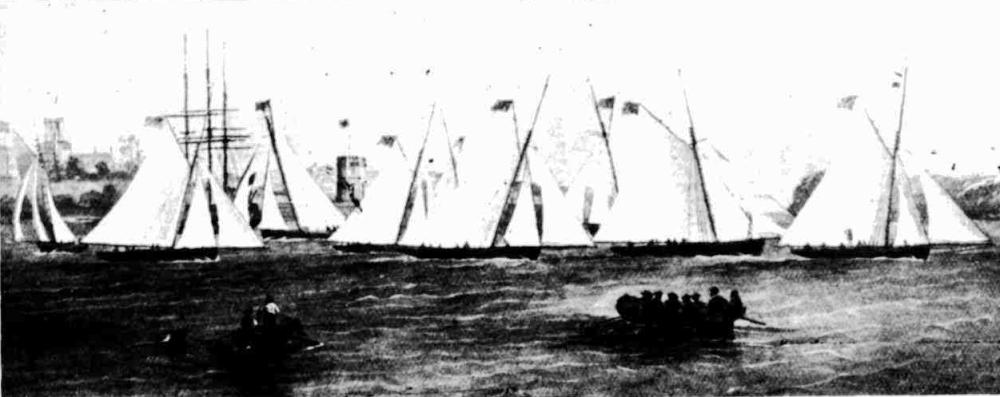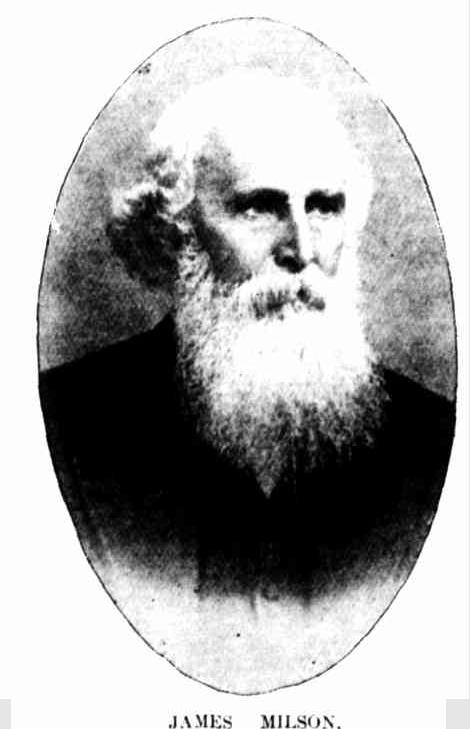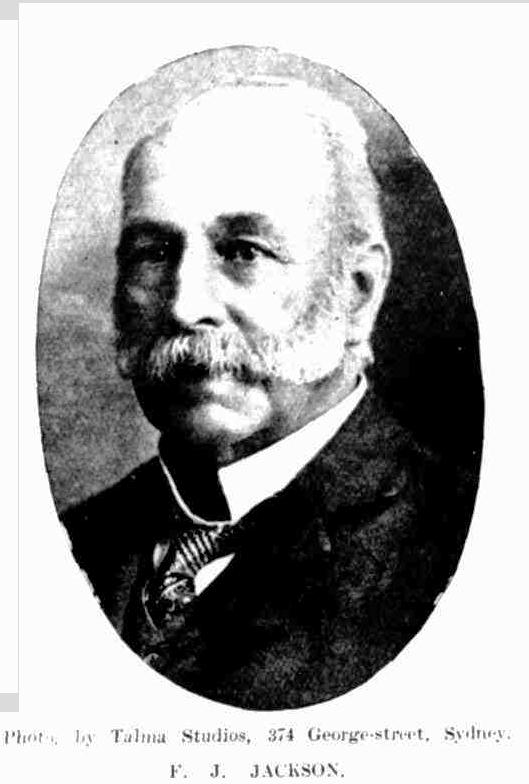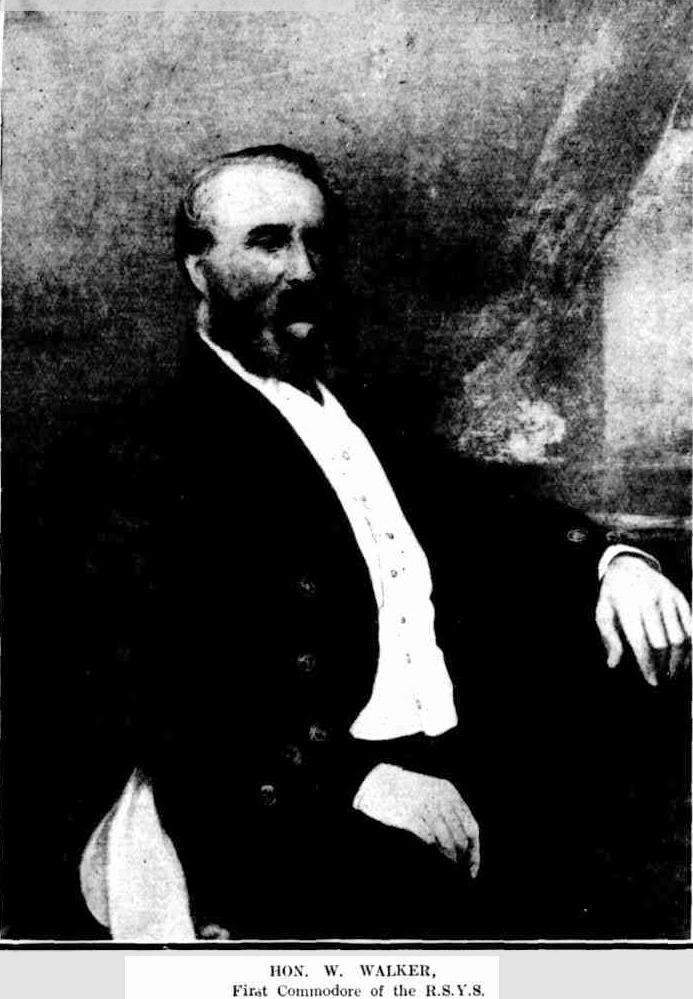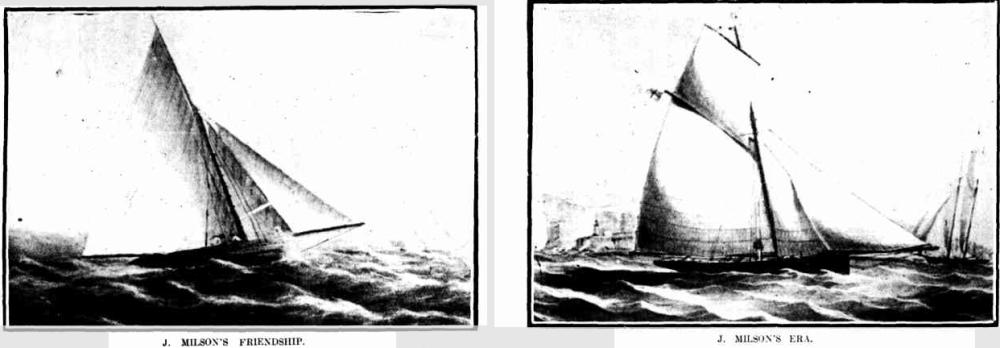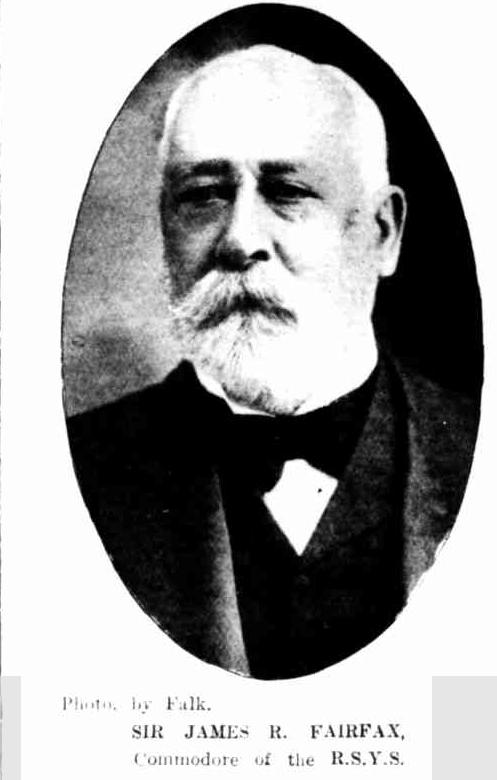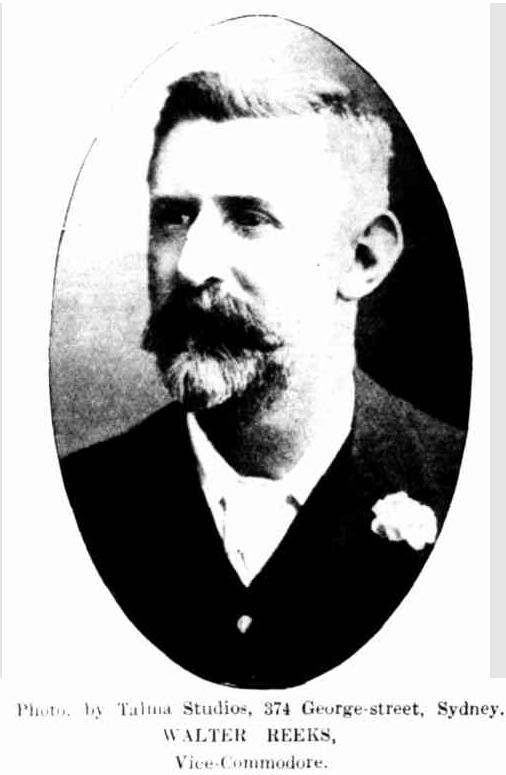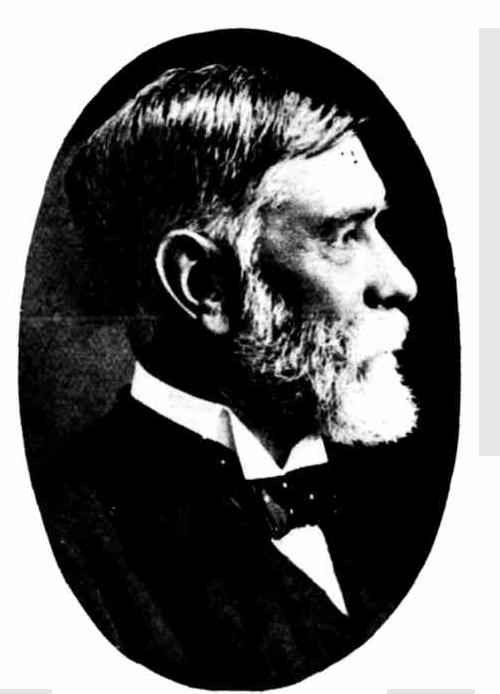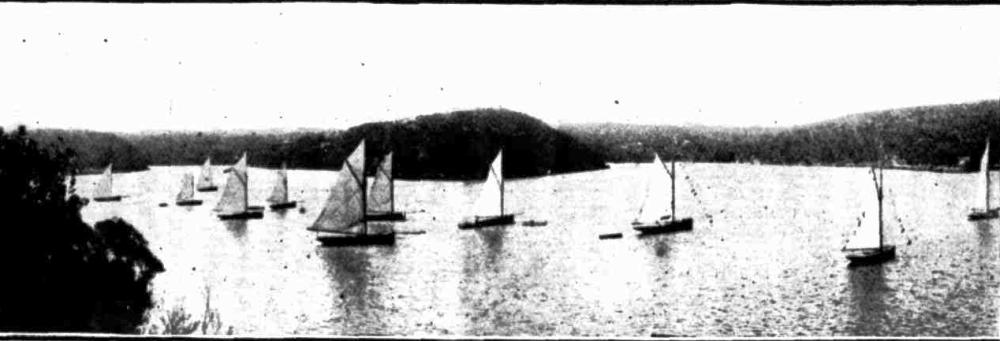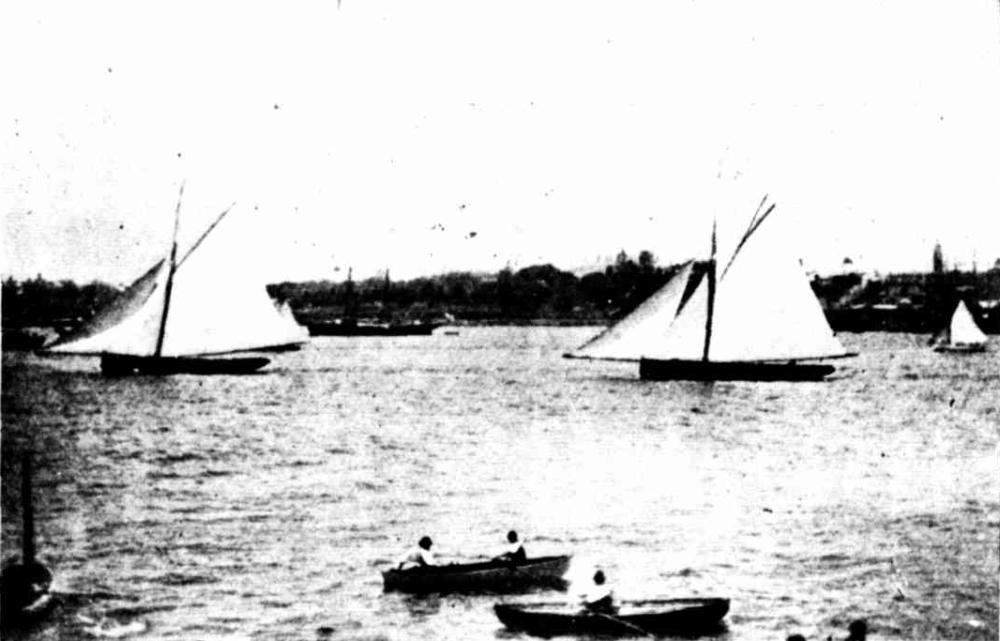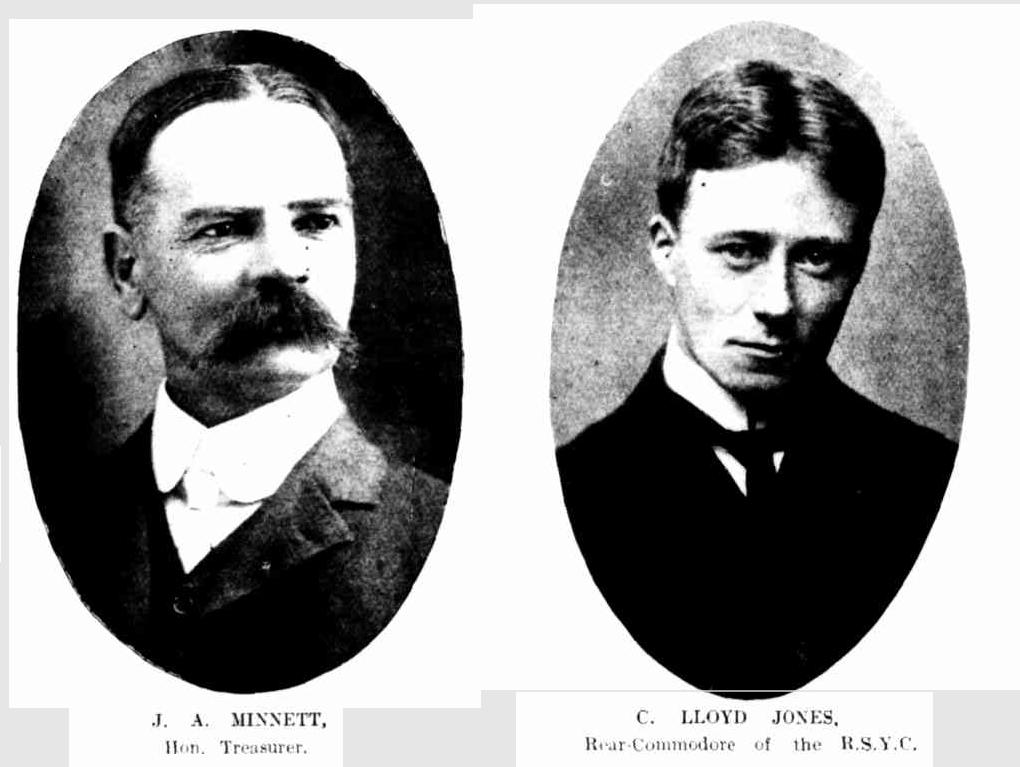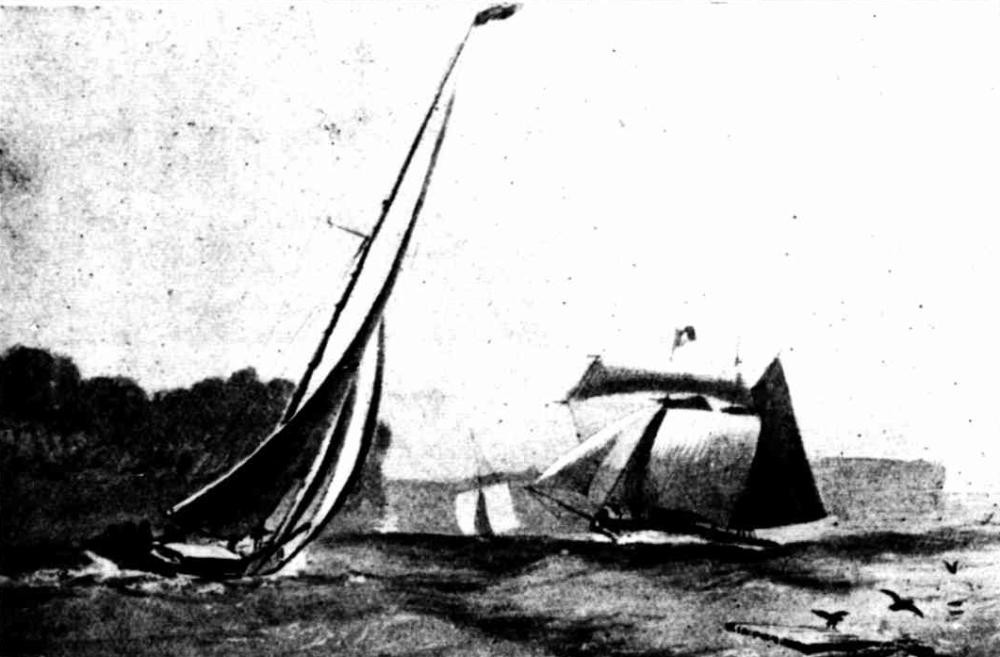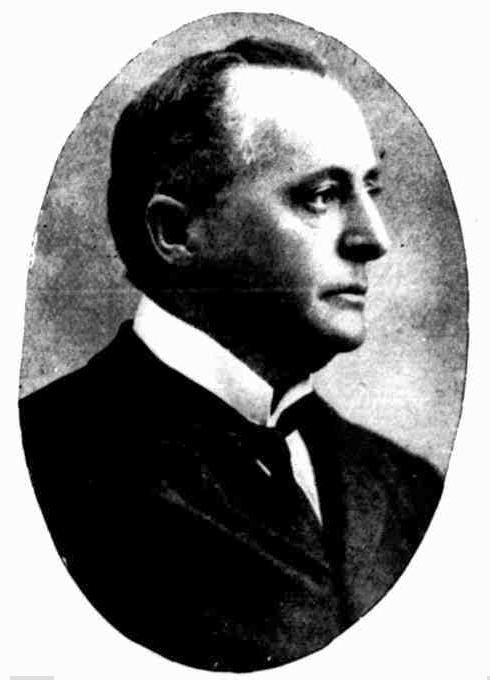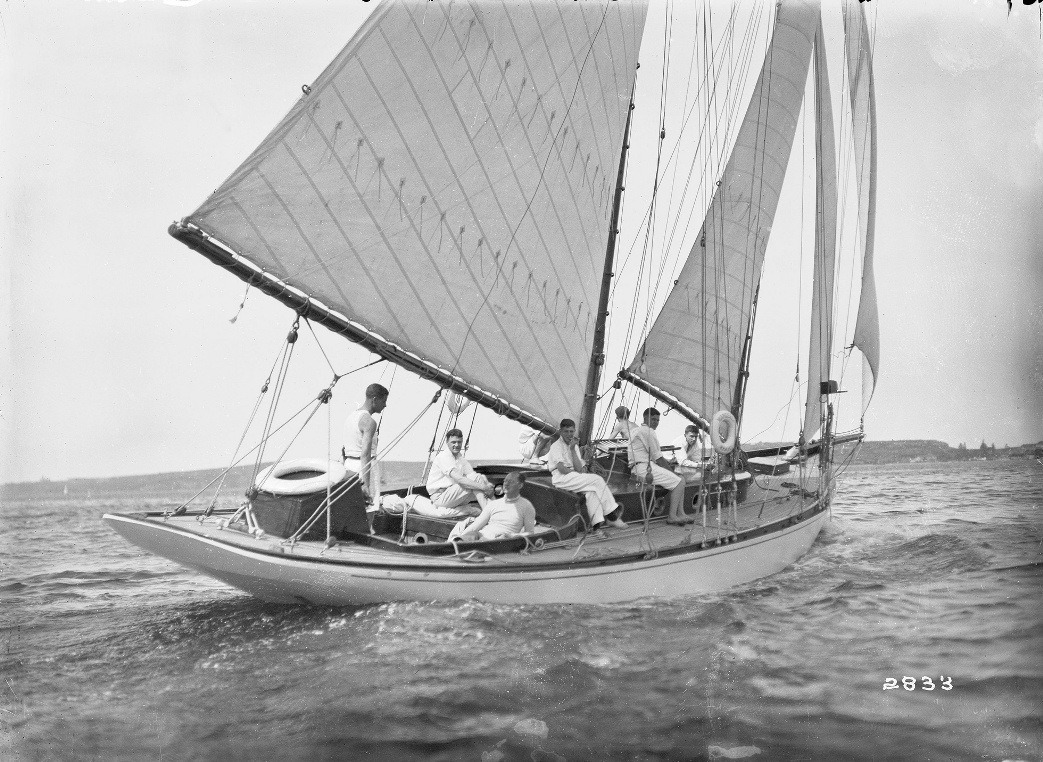August 28 - September 3, 2016: Issue 278
Royal Prince Alfred Yacht Club's 150th Sailing Season Opening: A Few Notes Of Old
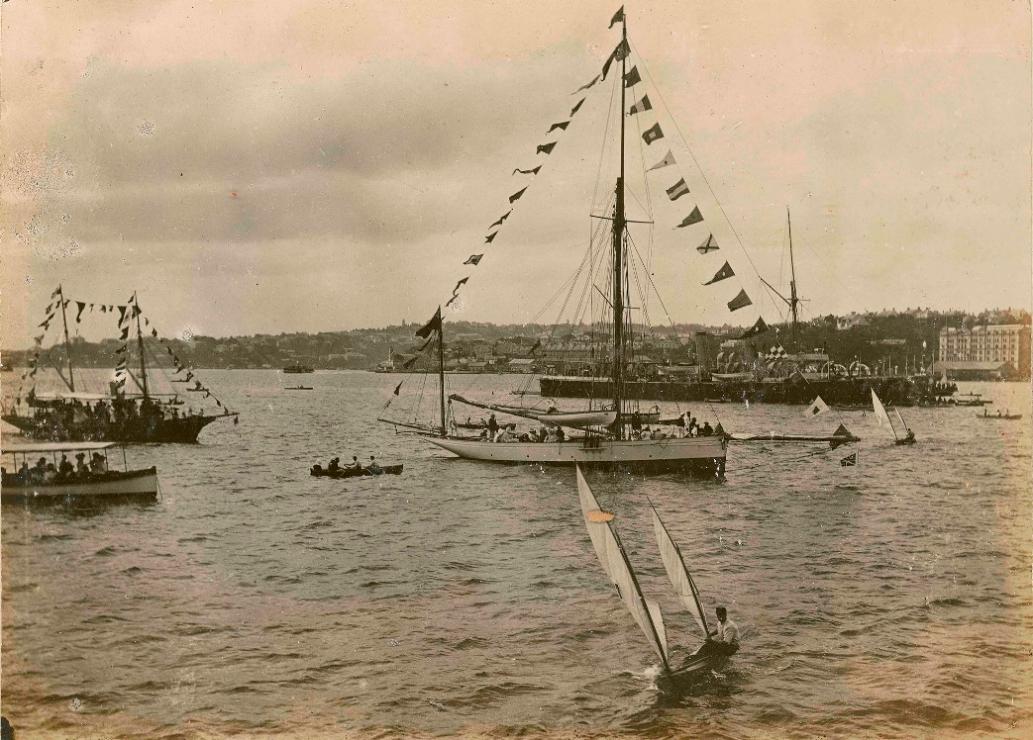
The annual meeting of the Prince Alfred Yacht Club was held on Tuesday last, at the Club-room, Punch's Hotel, King and Pitt streets, Commodore Hanks in the chair, read and confirmed several alterations in the by-laws were confirmed. After the minutes of the previous meeting were passed and five new members were elected. The appointment of officers for the ensuing year resulted in the election of Mr. J. G. Hanks (Psyche), as commodore ; Mr. W. E. Langley (Foam), vice-commodore ; Mr. W. Broughton Young, treasurer; Mr. W. Reading, hon, secretary ; Messrs. T. Strickland and C. Bransby,
Mr. Langley moved, " That the members of the P. A. Y. C. desire to express their regret at the loss the yachtsmen of New South Wales have sustained by the death of the late Mr. G. H. Howell, whose enthusiastic love of aquatic sports has for years aided in promoting a taste for yachting, to further which he devoted the energy of one who felt a warm interest in its success." Mr. Strickland proposed, " That a copy of the foregoing resolution be forwarded to the Commodore of R. S. Y. S." Seconded by Mr. Buchanan, and carried. It was announced that the dinner to ex-Vice-Commodore Strickland would take place this evening at Tattersall’s, and the race for his prize on the Saturday following the Balmain regatta.
The Prince Alfred Club in
Prince Alfred Yacht Club Race.
SATURDAY, NOV. 12.
The handicap yacht race for a silver cup presented by Mr T. A. Strickland, and for the club prize, came off on Saturday afternoon but, as none of the boats competing finished before 7 o'clock in the evening, no prizes-were awarded, and the race will have to be sailed again on Saturday 26th inst. The conditions of the competition for Mr Strickland's cup were that the yachts should be sailed by their owners, and manned by members of the Prince Alfred Club; but the contest for the cup prize was free from any regulations beyond those usually recognised in such matches. The course specified was -" From flagship in Snail's Bay round Lightship and Sow and Pigs, round flagship, thence round Fort Denison, and back to flagship. The following boats were entered and handicapped as under :
Australian. J. B. Graham, scratch
Eva. W. Andrews, 5 minutes,.
Josephine. C. Bell, 8
Ixion. T.Brown, 10 "
Orpheus..,.. -Howell, 10 ,. .
Psyche . J. G. Hanks, 15
Scud . H. Woolnough 15 "
Foam. W. F. Langley 17 "
The Foam did not start, and Orpheus, though she put in an appearance and sailed over the, greater part of the course, did not race. There was considerable difficulty in manning some of the yachts in such a way as to comply with the conditions which would entitle the winner to the Cup. Australian and Ixion had some non-members of the club among their crews, and they were consequently precluded from winning the principal prize though they were able to compete for the club prize. The boats wore rather slow in coming to the starting place, and the race did not begin until twenty minutes past three o'clock. They all got underway together, there being a very light northerly wind. Eva was the farthest to windward, then Scud, Josephine, Ixion, Australian and Psyche in the order named. Immediately after the start, Australian carried away her jib, and had to lay-to to set another, which, by the way, was only an apology for one. She lost considerable ground through this mishap. In standing down the harbour, Australian, Josephine, and Psyche had to make a board to clear Goat Island, and they lost considerably by doing so, Scud getting a good lead, which she was not deprived of till rounding the Lightship, and that owing to her standing too far into George's beach. No change took place in the position of the boats till after rounding Bradley's, with the exception of Australian going into third place; Scud, Australian, and Josephine working right across to Shark Point, all the others going about as soon as they could clear into Taylor's bay. Stretching into Chowder, Australian crossed Eva and gave chase to Scud, who was about 300 yards ahead, and going like a steamer; the stiff breeze suiting her all to pieces. Australian rounded the Lightship first, Scud 2nd, scarcely a fathom difference between them, Eva third, Ixion fourth, Josephine fifth, and Psyche last but very close up. In the run up, Australian left the lot, Josephine running up alongside Ixion and Eva, and the three going side by side until nearing Kirribilli, where Ixion and Eva did a great stroke by going in under the land, and so lost the wind; Josephine in the meantime sheared out & little more into the stream, and went away like smoke from her two rivals. The wind now began to get very light, and all hands gained considerably on the leading boats, bringing up the last of the breeze with them. Scud was collared and passed by all the boats off Goat Island, the Australian heine well up in Snail's bay, and the wind falling dead calm all hands had a dialling match for some considerable time. Australian and Josephine were the only boats to make any head at all, the others being as stationary as if at anchor. The flag-ship, which was moored about 60 yards from the southern shore of Snail's bay, was rounded in the following order :
H. M. S.
Australian . 5 23 0
Josephine. 6 44 0
Eva... 6 1 30
Ixion. 6 2 30
Psyche. 6 2 32
Scud ..... 6 10 45
After rounding there was another beautiful calm for some time, with now and then a light air for N. and N.W. About ten minutes to seven Australian turned about for flagship again, being at that time off Dawes point, Josephine and Ixion close together off eastern end of Goat Island, Eva and Psyche between Goat Island and Ball's head. As the Australian passed the Josephine and Ixion, the breeze began to freshen, and in a few minutes there was a splendid breeze ; Ixion was first round Fort Denison, Josephine about 5 seconds behind s Eva and Psyche, in close company, about 7 minutes astern of the leading boats, Josephine passed Ixion in the run home, and while they wore becalmed under Ball's head, Eva and Psycho came bowling along, and soon got to close quarters with them. Josephine rounded flag-ship, last time, 45900 ahead of Ixion, who was 2min ahead of Psyche, and Era last by a couple of seconds. If the race had been finished the Psycho would, without doubt, have carried off the Cup, and Ixion the "dumps." We were greatly astonished and pleased at the great improvement made in the speed of the Ixion and Psyche, especially the latter, who took a rare rise out of the handicappers.
We congratulate Mr Hanks upon the improvement displayed by his favourite yacht, and trust that he will have the pleasure of seeing her in front for some of the races during the season. Prince Alfred Yacht Club Race. (1870, November 19). Bell’s Life in Sydney and Sporting Chronicle (NSW : 1860 - 1870), p. 2. Retrieved from http://nla.gov.au/nla.news-article65473152
OFFICERS AND COMMITTEE PRINCE ALFRED YACHT CLUB.
The Prince Alfred Yacht Club was an outcome of the enthusiasm created by ' the sailor prince,' the Duke of Edinburgh, in the Galatea. Amongst the various memorials of his visit it was determined by a number of yacht owners to create a new yacht club, which would perpetuate in its name the memory of the royal visit. The new club received its warrant from the Admiralty to fly the Blue Ensign, under date 11th April, 1867; and its fleet has since been a prominent feature on Port Jackson. The club's sponsor is still its patron, as H.R.H. the Duke Alfred of Saxe-Coburg-Gotha ; and on a recent occasion the club members were assured by their other patron, Admiral Bridge, that the Duke still keeps up his interest in them. The present fleet consists of 15 vessels, aggregating about 160 tons— a steamer, three yawls, and the rest cutters.
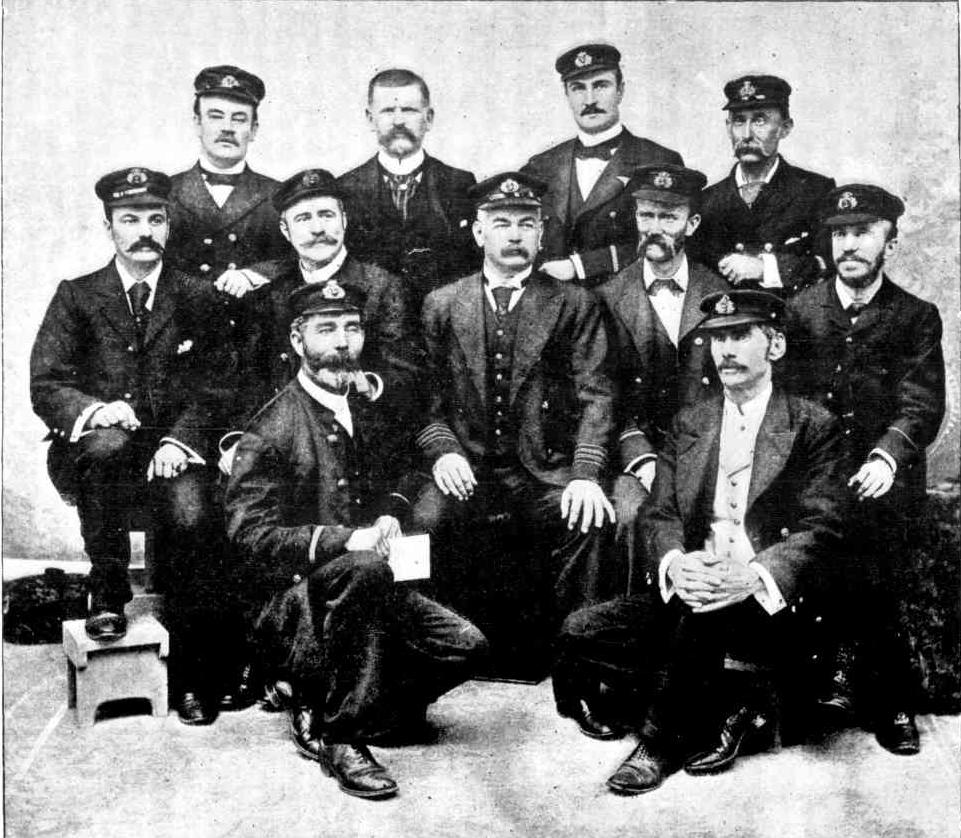

OFFICERS AND COMMITTEE PRINCE ALFRED YACHT CLUB. (1897, January 30). The Sydney Mail and New South Wales Advertiser (NSW : 1871 - 1912), p. 235. Retrieved from http://nla.gov.au/nla.news-article163793896
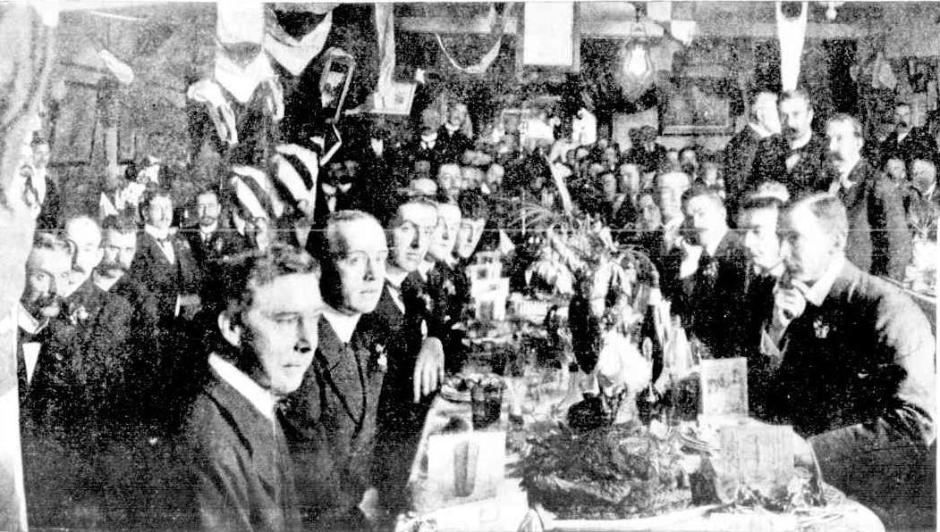
PRINCE ALFRED YACHT CLUB DINNER-FLASHLIGHT BY WYLIE.— See Aquatic Columns. Presentation to Lieutenant Hixson. (1900, August 11). The Sydney Mail and New South Wales Advertiser (NSW : 1871 - 1912), p. 325. Retrieved from http://nla.gov.au/nla.news-article163693316
Prince Alfred Yacht Club. OPENING OF THE NEW ROOMS.
At Bulls-chambers, Moore-street, on the 3rd last., a large company of yachting men assembled at the invitation of the Prince Alfred Yacht Club to partake of a dinner given in honour of the opening of the club's new rooms. Commodore S. Hordern occupied the chair, Vice-commodore W. M. Marks and
Rear-commodore H. A. Jones filing the vice -chairs. Amongst those present were Messrs. P. J. Jackson, J. H. Harris (hon. secretary), Sydney Dempster(hon. treasurer), Drs. Burne and Knaggs, and Messrs. A. Minnett (Royal Sydney Yacht Squadron),J. O. Fairfax (vice-commodore Sydney Amateur Sailing Club), Charles Helsham, H. W. Thallon, James Cox, C. T. Brockhoff, J. E. Chinnery, F. S. Adams, F. J. Donovan (commodore Johnstone Bay Sailing Club), A. C. Jewett, H. Mills (Mayor of Balmain), Russell-Marshall, James M'Intosh, J,F. King, F. G. Trouton, F. P. Pring, O. Backhouse, Tillock, Watson, Giltinan, C. Tayler, 3. E. O'Brien, Parkinson, W. H. Murrell, S. Stevens, J. George, and Lyons.
Mr. J. A. Minnett, of the Royal Sydney Yacht Club, proposed the health of the 'Prince Alfred Yacht Club.' For that club, he said he had the kindest feelings, as it was the first one he had joined in New South Wales, nearly 20 years ago. Then the club was a struggling institution. The chairman, in responding for the club, said he was pleased to hear Mr. Minnett say what he had said about Mr. Harden. The club was a successful one now, and had many friends. It was a live club. Sixty members as a rule attended its monthly meeting. The club was powerful because its members all pulled together, and the sinews of war were in the right place, namely, the bank. (Hear, hear.)It was an ambitious club, because it was anxious ' to instruct its members properly. He felt sure, through the way things were going forward, the club's two rooms would soon not be large enough to hold the club. Owing to the limited space now available the club had been unable to invite all its friends to be present. He trusted, when it was known, that excuse for not inviting them would be accepted. Some day when the club was able to build an establishment of its own and had a very large room it would be only too pleased to entertain all its friends. (Cheers.)
Mr. W. M. Marks, vice-commodore of the club, also responded. He said the man who had been the general of the whole campaign which had resulted in 'making the club as successful was Mr. Syd. Dempster. Mr. H. A. Jones, rear-commodore, said the reason the club had gone ahead, so well was because the members worked in harmony with one another. During the winter season the club rooms were made attractive, and in the summer season as many races as possible were arranged for as large prizes as the club was able to give. Next yachting season several new boats were coming out of one class, namely, 30-footers. They would give things a good start, and conduce to an interesting and exciting time. Mr. Sydney Dempster, who was heartily cheered, said he had been given a lot of credit, but he merely acted on the advice and according to the wishes of the house committee, and, as had been said, all pulled together. He thought the P.A.Y.C. ought to be proud of its position, for he saw before him one of the best meetings of yachting men which he had seen in Sydney for some years. There was a determination discernible to put yachting in Port Jackson on a better footing. (Hear, hear.) The old boats must be dropped, and English and American models would have to be followed. When that was done the rest might be left to the many energetic supporters of yachting in this community.- (Cheers.)
Mr. W. M. Marks, vice-commodore, proposed,' Kindred Clubs.'
Mr. Minuett responded for the Royal Sydney Yacht Club.
Mr. J. O. Fairfax, on being called upon to speak said when he accepted the invitation of the flag officers of the P. A. Y.C. to be present, he intended to appear purely in a private capacity, but as the club had received the toast in such a friendly spirit he had much pleasure in replying on behalf of the Sydney Amateur Sailing Club, thanking the P.A.Y.C.for its generous hospitality and good wishes. He saw a picture in an American piper the other day, of a big hairy caterpillar crawling along' a lawn. Seeing a lawn-mower approaching it, said,'I guess I will have my hair cut.' That was called taking advantage of opportunity. He was in the same position in accepting the invitation to the dinner, for he wanted to meet the men who were arranging to bring out the 30-footers and have a quiet yarn with them. Mr. Donovan responded for the Johnstone's Bay Club, and Mr. C. H. Helsham for the Anniversary Regatta committee.
Messrs. Parr Watson, T. Bainford, and W. H. Lynch sang a number of songs, accompanied on the piano by Mr. L. De Groen. Prince Alfred Yacht Club. (1900, August 11). The Sydney Mail and New South Wales Advertiser (NSW : 1871 - 1912), p. 354. Retrieved from http://nla.gov.au/nla.news-article163693372
YACHTING.
Prince Alfred Yacht Club.
The members of the. P.A.Y.C. have now established themselves in remarkably snug quarters in Bull's Chambers, Moore-street, where they have two large and comfortable rooms for themselves. The walls are hung with splendid pictures of well known "flyers," ancient and modern, while in the billiard-room there is a useful gift from the commodore (Mr. S. Hordern). The gift in question is a current chart, and by means of little machinery one is enabled to locate the currents, particularly those of the Southern Ocean, and on the east coast of Australia. The chart is not only useful, but valuable.
On August 3 the flag officers entertained a number of members and friends at dinner in the new rooms. The object of the gathering was to declare open the additions, and have a "jolly" good time. The both duties were performed right well by all present. The commodore (Mr. Hordern) presided, Mr. Marks (vice commodore) was in the vice-chair, while the rear commodore (Mr. Jones) was also in attendance. The visitors included Messrs. J. A. Minnett (of Royal Sydney Yacht Club), J. 0. Fairfax (Sydney Amateurs), F. J. Donovan (Johnstone Bay), and C. H. Helsham (University Rowing Club). Mr. J. A. Minnett proposed the "P.A.Y.C." in felicitous terms, referring to the good work of a former commodore (Mr. Harden)," then during later year's to what had been done by Mr. S. Hordern. Mr. Minnett expressed pleasure at being, present, and congratulated the club upon its present successful position.
The commodore, in responding, made a humorous speech. Afterwards he became, serious, and offered sound advice to the members of his club. They were now a powerful club, and to remain powerful it was necessary that they should pull "together". Further, they had made up their minds to make yachting one of the foremost sports of New South Wales. Mr. Marks also responded, and in the course of a capital speech, reminded the gathering that the P.A.Y.C. had a "good officer in Mr. Syd. Dempster. Speeches of a more or less humorous characters, were also delivered by Dr. Burne, Messrs. Dempster, Harris, and Jones. "Kindred Clubs" was the next toast honored, and it was drunk with enthusiasm, and acknowledged by Messrs. Minnett, Donovan, Fairfax, and Helsham. The meeting then resolved itself into "harmony." Songs were contributed by Messrs. Rainford, Watson, Lynch, and others. Selections were also given by De Groen's band. Mr. Harris was secretary for the evening, and is deserving of the heartiest praise for his efforts-in connection with the movement. YACHTING. (1900, August 11). Australian Town and Country Journal (NSW : 1870 - 1907), p. 54. Retrieved from http://nla.gov.au/nla.news-article71388101
Bull's Chambers, at 14 Moore Street Sydney (28 Martin Street, Martin Place, when the street name was changed) had recently been rebuilt after a disastrous 1890 fire which saw much of what we now call Martin Place and adjoining buildings and streets razed - at the loss of many firefighters lives.
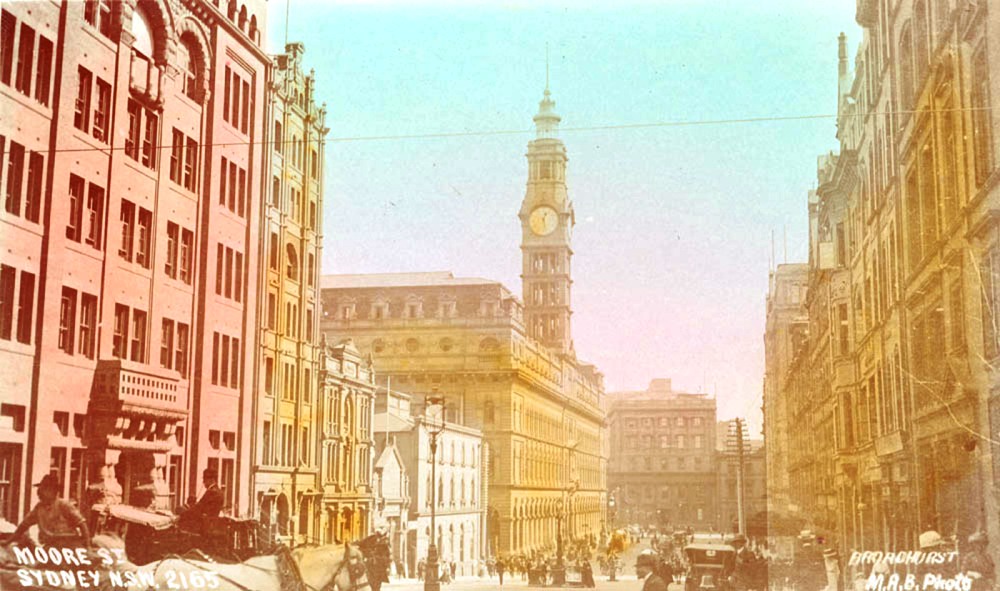
Moore St., Sydney, circa 1900 -1927, courtesy State Library of NSW, Image Number: a106233, from City streets and buildings, Sydney, N.S.W, Sydney & Ashfield : Broadhurst Post Card Publishers
On October 5th 1911, this announcement marked a name change for the club:
ROYAL PRINCE ALFRED YACHT CLUB. NEWLY-WON HONOURS.
The annual mess dinner of the Prince Alfred Yacht Club, given last evening at Paris House, was very largely attended, about 120 guests belonging to the Prince Alfred and other clubs being present. The chair was occupied by Commodore N. H. Murray, while the gathering further included Messrs. A. J. Milson (Vice-Commodore R.S.Y.S.), J. W. Bremner (Rear-Commodore R.S.Y.S.), O. Backhouse (Commodore Sydney Amateur Sailing Club), Captain Green and Captain Webber (of the Ancient Mariners' League), J. A. Minnett (hon. treasurer R.S.Y.S.), E. J. Jackson, S. M. Dempster, Dr. A. Burne, S. H. Falrland, C. J. Saunders, and J. S. D'Arcy.
The toast of "The King" was given by Commodore Murray. After Vice-Commodore A. J. Milson had proposed the toast of the club, Commodore Murray, In reply, said that it might be asked, "What are we doing to advance the interests of the sport?" For some time they had been pushing the sport to the best of their ability. At the present time the committee had under consideration a scheme to propound an Australasian regatta. The matter had been taken up with enthusiasm, and Sir Rupert Clark had given a hundred guinea gold cup for an all-yachts handicap.
The club was endeavouring to retain its position as one of the most active and progressive of Australian yachting corporations, and tonight marked an epoch in its history. He had received a letter from the Governor-General, stating that his Majesty the King had been pleased to authorise the prefix "Royal" to be conferred on the Prince Alfred Yacht Club. (Loud and prolonged cheering). He trusted that they might uphold the dignity of the Royal Prince Alfred Yacht Club to the best of their endeavour.
Mr. S. M. Dempster proposed the toast of "Kindred Clubs," to which Rear-Commodore Bremner and Commodore O. Backhouse responded, while the toast of "The Visitors," given by Mr. F. J. Jackson, was replied to by Captain Green. Mr. F. J. Empson proposed the toast of "The Press."
A quaint feature of the decorations of the evening was a miniature mast, erected on the central table, and adorned with small signal flags. The signals, translated, read: "I will not abandon you" and "I will stand by you," the signals of the Rawhiti. ROYAL PRINCE ALFRED YACHT CLUB. (1911, October 6). The Sydney Morning Herald (NSW : 1842 - 1954), p. 10. Retrieved from http://nla.gov.au/nla.news-article15279672
In 1919, the Committee decided that Sydney Harbour was becoming too congested for yacht racing and a sub-committee was formed to inspect land that would be suitable for yacht racing in the Pittwater area.
As a result, Green Point was purchased for this purpose for an amount of £650.
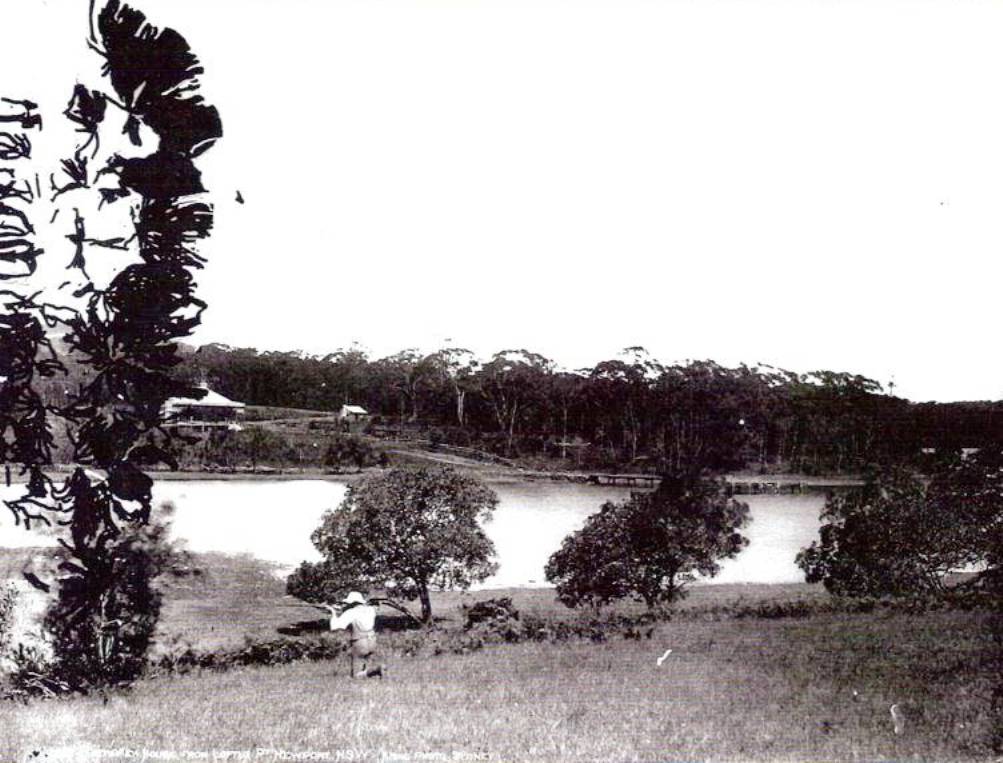
Bayview House from Loftus Point, Newport. circa 1900-1913 (Later named Green Point and site of present day RPAYC.) Photo Courtesy of Powerhouse Museum
The Royal Prince Alfreds will celebrate their opening the following Saturday with a rendezvous. All yachts and motor boats will assemble and then follow the commodore down the harbor to an anchorage in some suitable place where races for dingies and skiffs will be decided. The club's racing dates are as follows : November 15, December 13, January 31. February 24 and March 14. It will thus be noticed that both the yacht clubs will but contribute 10 races between them this season. What is the reason?
CLUBHOUSE AT BROKEN BAY.
One would have thought that after the long period of inactivity, during the war, yachtsmen would have taken advantage of the very earliest opportunity to demonstrate their enthusiasm for the sport, and that, consequently, every available date would have been secured for a fixture. It has been proposed that, in addition to their fine club rooms in Moore street, the Royal Prince Alfred Y.C. purchase a site at Broken Bay for a clubhouse. It appears that when he was in London, Commodore Walter M. Marks wrote the club that flying would be one of the sports in the near future, and that he was of opinion that the club should build a clubhouse at Newport on the land that Sir Rupert Clarke offered him some years ago, and where there was sufficient ground for hangars for air planing. The question is, it would seem, does the Prince Alfred Yacht Club intend altering its constitution to embrace flying as well as yachting ? And would the Royal Charter extended to the club as a yachting institution be permitted should it adopt flying?
THE NORTHCOTE CUP. By way of preparation for her Melbourne engagement, the yacht clubs have decided to arrange a series of test races for Mr. A. C. Saxton's six-metre yacht Awanui III. There will be either two or four races sailed in the harbor, when Awanui III. will meet Rawhiti (Fred Doran) and Culwulla IV. (W. M. Marks).
STORMY PETREL WELCOMED.
The return home of Mr. Sydney Dempster's Stormy Petrel, after a voyage of 5000 miles to Torres Straits, was the occasion of much interest to local yachtsmen, who turned out in strong force to welcome the much-travelled yacht and her intrepid crew at the Heads. The Lily Brayton conveyed members of the Royal Sydney Yacht Squadron, whilst a veritable fleet of other craft, including Mischief (Vice-Commodore A. J. Milson, Royal Sydney Yacht Squadron), Oenone (Commodore W. M. Marks, Royal Prince Alfred Y.C). Nanoya (S. H. Fairland). Bona (Bradley and Towse), Wingi Wingi (Bayley McArthur), Valencia (A. Davies), Istria (Colonel A. Spain), and Sirocco (E. W. Knox). Xhose aboard the Lily Brayton included Commodore Marks, Messrs. A. J. Langan, A. R. Marks, Capt. Webber, Capt. L. Phillips, F S. Adams, P. Pring, S. Coggins O. Backhouse, and H. Walters. In Watson's Bay the crew of Stormy Petrel assembled aboard the Lily Brayton, when their health was proposed by Commodore Marks and supported by Captain Phillips. The Stormy Petrel left Sydney on May 10 with her owner,' Mr. S. M. Dempster, in charge, Capt. S. C. Hutchins as navigating officer, Capt. S. Spain as mate, and Mr. E. P. Andrea3 as engineer. Needless to say, her cruise has been full of incident, from alligator shooting to a Digger wedding, when Warrant-Officer Jardinc, son of a well-known settler in the Far North, had the unique experience of being married to a young lady, who had nursed him through sickness, aboard the little yacht in Torres Straits. YACHTSMAN IS FOUND (1919, October 17). Arrow (Sydney, NSW : 1916 - 1933), p. 3. Retrieved from http://nla.gov.au/nla.news-article103526931
The site was used for gatherings and camping. In 1924 a caretaker was employed and the gates built, with a brass plate affixed, resolved in a meeting of August 7th, 1924, with the club's name. It was also resolved to accept Oscar Curtis' offer of the Bona mast as the first flagpole for the club's new site. This classic yacht had won what was termed 'The Australian America's Cup Yacht Race' in the Sayonara Cup and numerous other races the RPAYC yachtsmen either supported or raced in. When the gates were built a jetty was also installed. John Roche, called by many the 'Father of the Pittwater Regatta', was a member by this time and asked, along with others, to decide on the appropriate spot for the flagpole.
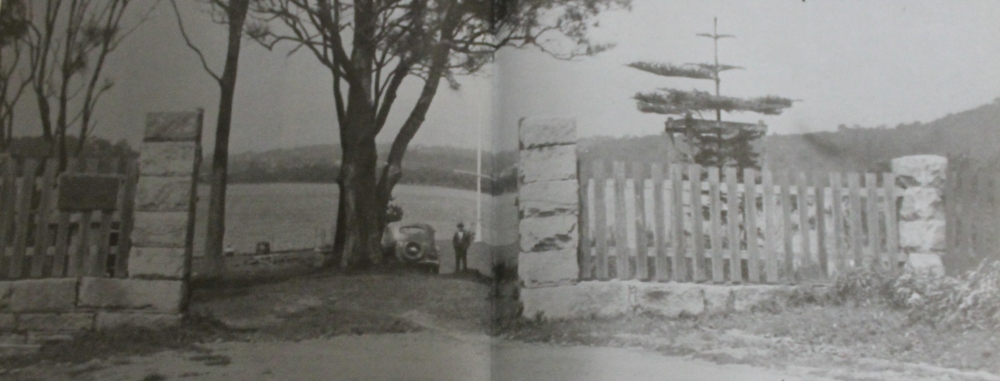
In September 1924 Russell Marshall presented a shed to the club for the Green Point grounds and this would appear to be the first building on the site.
In October 1926 12 moorings were secured for club members - 6 at Salt Pan and 6 at Green Point.
Apart from tree-planting ceremonies, the land remained practically unused until a group of enthusiasts, who had built Jubilee class yachts, banded together and built a boatshed, slipway and pontoon to cater for their needs. The Governor of New South Wales, the Honorary Commodore of the Club, Lord Wakehurst, officially opened the current premises on 17th December, 1938. No less than 22 Jubilees started in the race held that day. This was a relatively new class which the progressive from its outset club chose to sponsor and promote:
RPAYC Tree Planting TREE PLANTING On Yacht Club's Newport Land.
Many trees and flowering shrubs were planted yesterday on Green Point, near Newport, Pittwater. The ceremony was performed by various members of the Royal Prince Alfred Yacht Club, owners of the land, which forms a feature of the foreshores of the upper end of Pittwater.
Mr. J. S. Palmer, an old and prominent member of the club, was responsible for the suggestion to carry out the tree-planting. By making a contribution from the prizes he had won in past years, he enabled the work to be done. One of the trees was planted by Mr. Palmer in memory of his son, the late Mr. L. Palmer, who was killed in an aeroplane accident last year. The others were planted by prominent past and present members of the club, including Messrs. D. Carment, F. S. Adams, and W. M. Marks. TREE PLANTING. (1932, November 21). The Sydney Morning Herald (NSW : 1842 - 1954), p. 6. Retrieved from http://nla.gov.au/nla.news-article28029956
OPENING OF SAILING SEASON. Pleasant Setting for Carnival at Green Point.
White-winged yachts on the wind-ruffled waters made a lovely spectacle at the opening of the Pittwater sailing season on Saturday afternoon, when the new boathouse of the Royal Prince Alfred Yacht Club at Green Point, Newport, was opened.
The majority of spectator wore dark glasses and large shady hats as a. protection from the hot afternoon sunshine, and coloured beach umbrellas were erected on the lawn to provide additional shade.
When the Governor, Lord Wakehurst, who is the honorary commodore, and Lady Wakehurst disembarked from Mr. J. M. Hardie's yacht Windward they were welcomed by Commodore P. C. Mackillop, Vice-Commodore Richard Windeyer, and Rear-Commodore D.S. Carment. Lady Wakehurst locked cool in a chalk white silk sports frock belted in navy, and a white Breton sailor hat trimmed with a large bow in front. Mrs. Hardie's navy linen frock cut on tailored lines was relieved with touches of blue.
OFFICIAL QUESTS.
Afternoon tea was served in a marquee on the lawn, and among the official guests were Admiral W. N. Custance, Captain and Mrs. H. C. Phillips, Colonel and Mrs. P. H. Lorenzo, Flight-Lieutenant and Mrs. Norman Mulroney, Group-Captain and Mrs. H. P. de la Rue, Mr. and Mrs. J. L. Milson, Mr. and Mrs. D. S. Carment, and Mr. and Mrs. L. C. Waterman.
Mrs. H. C. Phillips wore a white tailored linen emit with a plowed navy skirt and white hat. A sky blue linen frock patterned with a nautical design of anchors and life buoys was the choice of Miss Susan Phillips.
Mrs. P. Carruthers's -white linen frock was trimmed with emerald green zipp fasteners on the -pockets.
Commander Leo Quick whowas accompanied by Mrs. Quick, who wore a wide-brimmed black straw hat with her black and white printed silk frock. Mrs. T. M. Furber, whose husband is a club member, favoured a navy frock patterned with white stars. Miss Nancy Furber's green and white spotted frock was finished with a white Peter Pan collar.
SAILED FROM NEWCASTLE.
On board the Runette, Mr. W. Giles, a member of the Lake Macquarie Yacht Club, who sailed from Newcastle in the morning, entertained Mr. and Mrs. P. Martin, Mrs. James Crawford, and Miss Helen Telford.
Mis Sheila Pring, wearing s wide-brimmed White hat with her cream American crepe frock patterned in black, accompanied her fiancé, Mr. Geoffrey Plater With Mr J. Hordern was Miss Sheila Vale and her sister, Miss Joyce Vale. The latter chose a primrose yellow printed silk frock with a shady hat
Mrs Andrew Findlay was a smart figure in a navy linen culotte and white terry cloth shirt finished with a nautical navy scarf
Miss Jeannette Lang, who was with Mr. Harry Wearne, wore a turquoise blue pinafore frock with a matching blouse which had Hungarian embroidery on the puffed sleeves. An all-white ensemble was the choice of Mrs. Hamilton Kirkland. Mrs. Paul Ross wore a navy and white printed American sheer frock, and navy and white was also chosen by Mrs. L. C. Waterman, whose husband is the president of the Sydney Yacht Racing Association. With Mr. and Mrs. Monte Fowler was Miss Peggy Leslie in a red and white patterned cotton frock. Mrs Fowler wore a navy bolero coat with her white American crepe frock
Other spectators included Mr. and Mrs A.D. Walker, Mr. and Mrs F. F. Buchanan, Professor and Mrs. W. J. Dakin, Messrs "TV.Jira, Clive Evatt, John Wallis, Harold Adams, Arthur Mutson, and John Kyd (secretary of the club).
(Continued on next page.)
OPENING OF NEWPORT BOATHOUSE.
MRS. F. C. MACKILLOP, wife of Commodore Mackillop, and LADY WAKEHURST at the opening of the Royal Prince Alfred Yacht Club boat-house and sailing season at Green Point, Newport, on Saturday afternoon.
MISS SHEILA PRING, MRS. SYDNEY CROLL, MR. PHILIP PRING, and MRS. L. MARSDEN enjoyed afternoon tea on the lawn at the opening of the Royal Prince Alfred Yacht Club boathouse and sailing season at Green Point, Newport, on Saturday afternoon. FOR WOMEN. (1938, December 19).The Sydney Morning Herald (NSW : 1842 - 1954), p. 3. Retrieved from http://nla.gov.au/nla.news-article17549811
Today, as 150 years ago, the Royal Prince Alfred Yacht Club remains known for promoting the sport of sailing in every age group from youngsters through to mature first-time social sailors. The club is has among its members some of the finest yachts in all classes and remains promoters of new classes of yachts as these and the sport evolves.
A few of the more famous of these yachts will run prior to the Long Weekend of October 1-3 when a Pittwater Regatta will be run by the club whose then younger and yet to join members began what would become one of the most popular Regattas in Sydney.
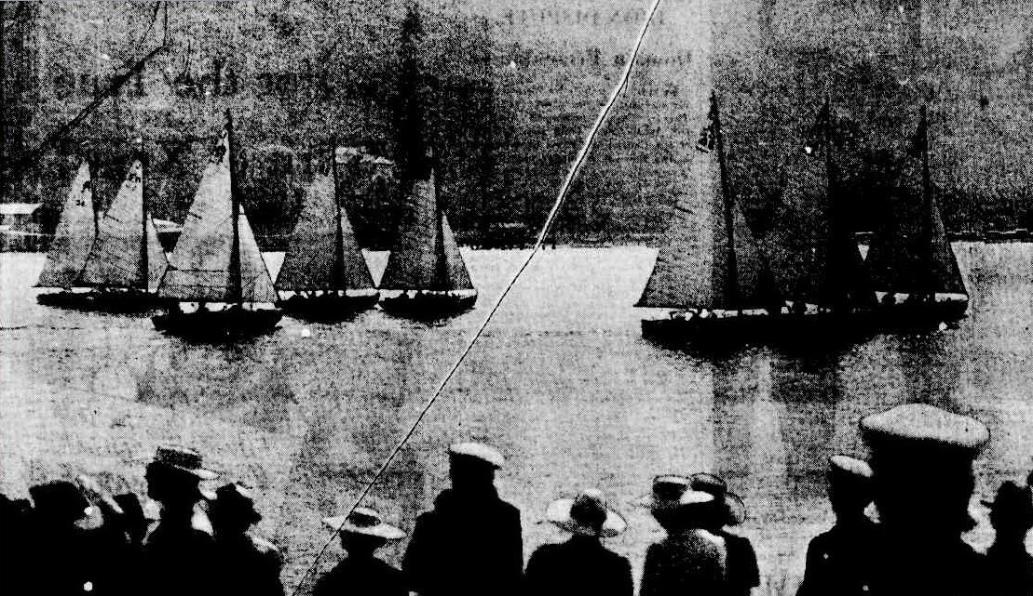
YACHT SEASON OPENED AT PITTWATER
The opening of the Royal Prince Alfred Yacht Club's Pittwater season took place at Green Point on Saturday, when the new Jubilee class yachts raced for the first time. The Governor, Lord Wakehurst, opened the season. The yachts are shown soon after the start, on their way to Scotland Island. From left: Jubilant (A. G. Muston), Oweene (J. A. Pollack), Mayrah (M. R. Alexander), Fleetwing (D. C. Brockhoff), Aloha (R. S. and C. G. Littlejohn), Topsy (C. C. Toothwell), Noela (C. V. Stevens), and Forty Sixty (R. C. Kent). YACHT SEASON OPENED AT PITTWATER — 18-FOOTER CAPSIZES ON HARBOUR — DUNN SHIELD ATHLETICS (1938, December 19). The Sydney Morning Herald (NSW : 1842 - 1954), p. 14. Retrieved from http://nla.gov.au/nla.news-article17549784
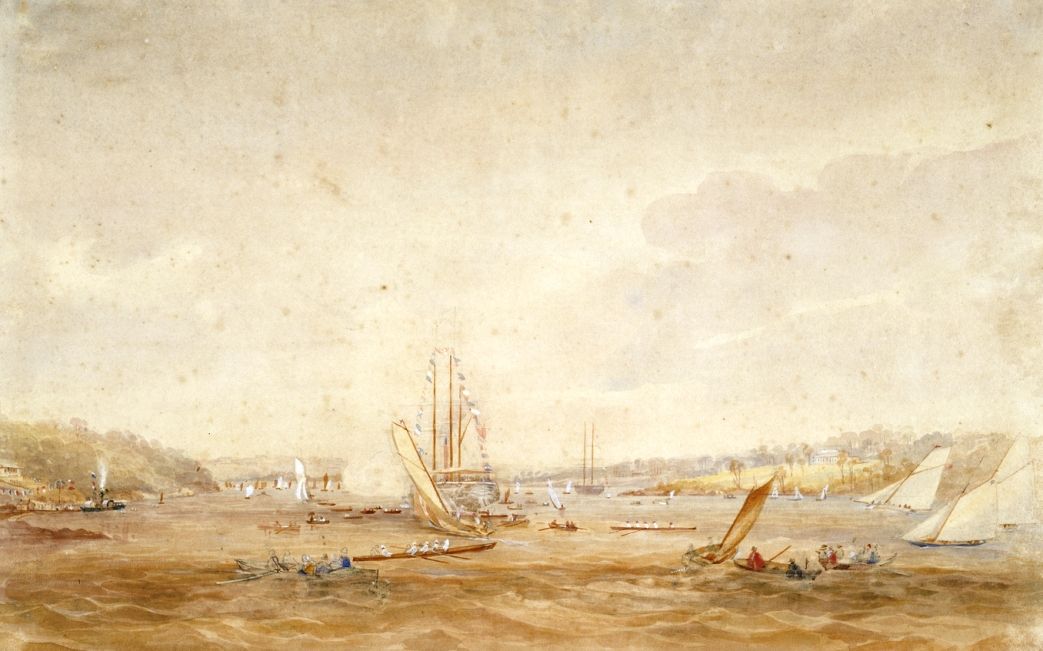
The Basin, Pittwater: A Reprise
Easter Cruises to Pittwater - from 1893
Port Jackson's Pleasure Fleets - No 1 and 2 (1907) - Ancient and Modern
Port Jackson Pleasure Fleets No:11 and 12: Clubs, Flags and the Advantages of Sailing
The Good Ship Packham - Part I
A Salty Tale of the Kathleen Gillett A Small Reminder and Celebration of Our 70th Sydney to Hobart
The Kalori The Bona - Classic Wooden Yacht The First Pittwater Regatta John Roche
Pittwater Regattas Part I - Dates and Flagships to 1950
Pittwater Regattas 1907 and 1908 Pittwater Regattas - 1921 - The Year that Opened and Closed with a Regatta on Pittwater Pittwater Regatta Banishes Depression - 1933 The 1937 Pittwater Regatta - A Fashionable Affair
The First Scotland Island Cup, Trophy and Race and the Gentleman who loved Elvina Bay
MOSQUITO YACHT CLUB.
The first sailing match with yachts owned by members of the Mosquito Yacht Club, took place yesterday. The following yachts wore entered for the match :
Annie S., Curtis
Daring, Dodds
Will Watch, Turner
Volante, Leader
Sea Belle, Macdonnell
Dolphin, Donaldson
Sylvie, Johnson.
The four first-named were the only boats that started. The prescribed course was to start from the Red Buoy, proceeding round the " Waterhen" in Darling Harbour, thence round Lightship and Sow and Figs, back round the steamer in Johnson's Bay, thence round Shark Island, and back to the Red Buoy, passing between it and the Flagship.
The committee had engaged the Black Swan, steamer, for the accommodation of members and their friends, and to accompany the boats in case of accident. The day, which looked lowering and stormy in the morning, cleared up before the hour of starting, and there was just enough of wind blowing from the north-east to bring into play the judgment of the crews, as well as to test the quality of the boats.
The Black Swan, after taking on board those who had received tickets from the committee, including a number of the fair daughters of New South Wales, steamed out near the Starting point. At eleven o'clock the boats started, the Will Watch taking the lead the Annie S, soon overhauled her, and on entering Darling Harbour the Annie S, and Will Witch ran for some distance nearly abreast, the Daring and Volante followed at a considerable distance, and the latter soon gave up. The boats reached the Waterhen in the following time :-Annie 30 minutes past ll, Will Watch 31 minutes past ll, Daring 32 minutes past ll. Here the Daring carried away her peak haulyards, and gave up. The Annie S. and Will Watch had now the race to themselves, and they were so well matched that the interest of the spectators was kept up to the very last. When opposite Pyrmont the Annie S. broke of, and the Will Witch again took the lead for some distance, and then both boats stretched away for the entrance to the harbour. The sight was a beautiful one, for tho breeze was fresh, and the boats almost buried in the silvery spray thrown up by the swiftness of their course through the water seemed in the distance like two enormous water-fowl skimming the surface of the magnificent harbour, while the steamer hovering near with her blackened spars, and her chimney emitting volumes of smoke, appeared more like some evil genie watching her opportunity to destroy than the guardian she really was; what a freight of youth, beauty, and happiness covers the deck of that steamer; sweet music discoursed by the band, and the still sweeter laugh, because telling of the inward happiness of the dancers, might be heard far and wide over the brood surface of the ruffled waters. Thus they swept on past the beautiful bays and romantic headlands that surround the harbour, and justify the opinion given by many travellers, that Port Jackson is the finest harbour in the world. When within a short distance of the Lightship the Will Watch ran ashore, with her top streaks started ; this detained her a few minutes, and indeed, decided the race, for the Annie S. kept a-head during the remainder of tho race-followed very closely by her rival. The Annie S. arrived at the flag-ship at half-past 3 o'clock, and the Will Witch was only 2 minutes in following her, amid the repeated cheers of the company on board.
This, the first match of the club, may be said to have passed off remarkably well, although, of course there were, as always happens in new institutions, mistakes and omissions in the arrangements, which experience only can remedy ; and if we may judge from the spirit evinced yesterday, there is little doubt the Mosquito Yacht Club will soon take rank among the many public institutions of which this portion of Australia is justly proud. MOSQUITO YACHT CLUB. (1856, October 14). Empire(Sydney, NSW : 1850 - 1875), p. 5. Retrieved from http://nla.gov.au/nla.news-article64978110
RULES AND REGULATIONS OF THE MOSQUITO YACHT. (1856, June 28). Empire (Sydney, NSW : 1850 - 1875), p. 4. Retrieved fromhttp://nla.gov.au/nla.news-article60249911
SYDNEY YACHT CLUB
The subject of yachting, when taken into consideration with our magnificent harbour- allowed to be the finest in the world-is one which all patriotic Australians must allow ought to be maintained here as a national sport. We feel sincere pleasure in giving publicity to aught that will contribute to spread a taste for, or that will tend to elevate, this noble and manly diversion. Notwithstanding the dulness which has for some years past prevailed amongst the lovers of aquatic sports, the true chivalric feeling has not been suffered to die out altogether ; and we are happy to find many amongst us who possess the proper spirit with regard to yachting ;many who are willing to give their best aid towards raising yachting to a higher position than it ever yet occupied in the history of this colony.
In support of this we have only to take a short retrospective view of yachting affairs-say for the last eighteen months,-see the yachts that have been built in the colony during that time, see the yachts that have been brought from the mother country to compete for the laurels to be won in Port Jackson. There cannot, therefore, be a doubt that the true taste for this sport is reviving with increased vigour, though almost imperceptibly to a casual observer. Then the recent establishment of two yacht clubs-the "Sydney Yacht Club," and the " Mosquito Yacht Club," -are facts which cannot be regarded otherwise than as indications of the increasing interest that is being manifested, and which must be a source of gratification as tending to give additional impetus to the development of this favourite amusement.
It is with the first named club that we have more immediately to deal, pursuant to previous announcement, the first sailing match for all yachts duly registered on the books of the club, came off on Saturday last The day was of the most desirable character-though a little too warm, a blight and almost unclouded sky, and a fresh north easter blowing, raised the hearts of the anxious competitors. Five yachts were entered to contest for the prize, a very neat silver cup-or, rather, " claret jug'-valued at 35 guineas -
Mr W Thompson's Eclipse .
Mr J Cuthbert’s Enchantress
Mr J Milsom's Mischief
Mr I S Dean's Challenge
Mr J Bramwell's Preston
The course laid down was the following To start from the mooring laid down in a line between the red buoy and Dawes' Point, thence round a flag boat moored in Big Manly Bay , returning round the flag ship off Fort Macquarie, then proceeding round the Light ship and Sow and Pigs, and back to the flag ship-leaving nilrounding points on the port hand, except at the finish when the yachts had to pass between the flag ship and the reel buoy L ho steamer Victoria, with a band of music on board, was at the Circular Quay by half past ten o clock a m , to convey the A ice Commodore and members of the club and their friends down the harbour to watch the race There were not less that one hundred and fifty persons on board, about half the number being of the gentle sex. The bright eyes and the pretty faces of the ladies, and their varied dresses, with the gay uniforms of the members of the club formed a scene quite charming Every one seemed determined to be pleased, although there was somewhat of a want of room. About half past eleven the yachts were at their moorings, and the steamer then left the quay to witness the start the Customs yacht Satellite, with the Vice Commodore (Captain Browne on board, bore up and brought to an anchor, taking her station as flag ship All the preliminaries being adjusted the signal for starting was given precisely at twelve o clock.
THE RACE
At the firing of the gun the yachts almost simultaneously hauled up their peaks. The Challenge got under weigh fast, the Mischief (having the windward station) next, the Eclipse and the Enchantress together All the bouts stretched over to Kirribilli Point on the starboard tack, as closely as possible , the Eclipse and the Challenge went about together, the former taking the windward station and setting her gill' first , the Mischief followed third, and the Enchantress last, they sailed past Farm Cove all in a bunch. The Mischief had some difficulty in setting her gaff, so also had the Enchantress , but they eventually shook out their canvas to the breeze. The boats again tacked near the north end of Garden Island , the Eclipse first, the Challenge second, the Enchantress close up in the wind in fine style, third, and the Mischief log-like, visibly losing ground They then bore up for Mossman's Point, the Eclipse sailing in the winds eye, and after going about close to the shore increased her lead at every length, the breeze at that time freshening. The Challenge and the Enchantress followed across to Mossman's in the wake of the Eclipse, the Enchantress being lo windward, though the Challenge»as to leeward she was ahead of the Enchantress As they neared the shore between Cremorne and the Point, the Challenge went about, but she had hardly got way on when the Enchantress was put up in the wind, and began to shake (whether 01 not it was bei intention to gi about we cannot say), and the Challenge in crossing the Enchantress's bows got foul of her bowsprit which went through her mainsail Both boats fell broadside on to each other. The foul caused a delay of about a minute, and speculation was rife on board the steamer as to which boat was in fault. The rules of the Club are that the yacht on the port tack must give way to the yacht on the starboard tack, but it could not well be determined, in the opinion of many, that the Enchantress was on the starboard tack at the moment of the collision, though certainly the Challenge was on the port tack The O'currence was natural enough, the Challenge being slightly ahead, hut to leeward, endeavored to get to windward of the Enchantress,(a point worth trying for) by going about first, the Enchantress seeing this, and knowing that by all laws of yachting she might " shake" if she pleased-when on the starboard tack going to windward-immediately put up her helm. The two boats were so close together that if the Challenge-after going about-had tried, shocmid not have given way to the other by going astern as -he would thereby have lost all she had gained in the previous board, and probably come into collision with her As it was, she followed the only course open for her, and she endeavoured to clear the Enchantress, but the effort was not attended with success, as the corner of her mainsail was caught by the bow sprit of the Enchantress. However, neither of the boats lowered her distinguishing flag in protestation so that the foul could not, under any circumstances, have been entertained. The Challenge gained for the none« by the occurrence, she hann? got under way considerably be-fore the Enchantress. The Eclipse continued increasing her distance , and it was plain that if the wind kept up none of the others had a chance with her The Mischief brought up the tail of the race. The leader went away down this side of Point Piper and then made a board over to Bradleys Head, from thence close hauled towards Shark Island. The other three boats in the same order kept close along the North Shore to Bradley s, across to Chowder Bay on the starboard tack and then down to the Bottle and Glass, on the port tack was the leader’s rule. From thence each boat was left by the spectators to exercise her own judgment, as there was plenty of wind and good sea room The steamer then made direct for the flag boat at Manly, and awaited the îs'Ue of the rounding of the yachts. The Eclipse rounded at 21 m. 30 sec. past, the Enchantress 27 m. 30 sec , the Mischief 38 ra.55 sec ; the Challenge, 31 ni. 10 sec., there being a difference of 10 m. 40 sec between the first and last boat». It was now thought that the Enchantress would show some running and overhaul the Eclipse, but it was soon seen that this could not be the case. This was about the most picturesque part of the race, each boat had all her available canvas hung out as much as she could carry. The same order was main turned to the flag-ship. The boats, except the Challenge, took in all their Epnre sail to gibe round the flag-ship. The Eclipse rounded at 14 m.45 sec. past 2; the Enchantress, l8 m. 45 sec; the Mischief, 84 m. ; the Challenge (passed) 3G ni., and then ran home. The Enchantress, it will be seen gained two minutes on the Eclipse in running before the wind. The race down to the Sow and Pigs and light-ship was of much the same characters as when the boats went down the harbour the first time. The Eclipse rounded at 10 ra. 40 sec. rast 3 ; the Enchantress, Ki m.20 sec. ; the Mischief did not show round. The run home did not occupy much time, the Eclipse passing the ling-ship at 43 m. 44 sec. past 3 ; the Enchantress, 40 ra.25 sec. ; the Eclipse winning by nearly 4 minutes. The time occupied in sailing the entire course, which is considered not fur short of 30 miles, was 3 li. 42 m. 44 sec. On the firing of the gun announcing the finish of the race, the successful yacht was greeted with three hearty cheers from the steamers.
On beard the steamer, which accompanied the yachts all through the race, the majority passed their time pleasantly in paying homage to Terpsichore; though there was not much room for dancing, a goodly array continued to trip the light fantastic. Pleasure beamed on every countenance ; and when Mr. R. Harnett, who steered the Eclipse, came on board, he was congratulated in the heartiest manner upon his success. Captain Browne presented the prize, with the addition of a cheque for 10, to the owner of the Eclipse, W. Thompson, Esq., and, in proposing his health, complimented him in an appropriate speech on his good fortune. Mr. Thompson returned thanks, and acknowledged his obligations to Mr. Harnett and the crew.
The result of this race-one of the best contested we have ever seen-seemed to give general satisfaction.The Eclipse and the Enchantress were both handled in a style which called forth the admiration of all spectators As the sun was ye, high, it was proposed for the gratification of the ladies, to go down the harbour again; this met with a ready response, and the steamer continued plying up and down the harbour till near sundown. As she came up for the last time she passed astern of her Majesty's ships Juno and Herald, the band striking up the National Anthem. The compliment was returned by both the vessels dipping their ensigns. Thus concluded a day of the most entertaining character. With all the perceptible deficiencies almost necessarily attendant upon a maiden effort, we conclude by wishing success to the Sydney Yacht Club. SYDNEY YACHT CLUB,. (1856, December 1). Empire(Sydney, NSW : 1850 - 1875), p. 5. Retrieved from http://nla.gov.au/nla.news-article64980595
STRICKLAND. On June 3, drowned by the upsetting of his boat off North Head, Thomas Arthur Strickland (late of the firm of Messrs. Young and Lark), a colonist of over 30 years. Beloved, respected, and regretted by his family and friends. Aged 53 years. Family Notices (1888, June 5). The Sydney Morning Herald (NSW : 1842 - 1954), p. 1. Retrieved from http://nla.gov.au/nla.news-article13688366
THE DROWNING OF MR. T. A. STRICKLAND.
Yesterday afternoon, the City Coroner, Mr H S. Shiell, J P , began an inquest at the Grand Pier Hotel, Manly, concerning the death of Mr Thomas Arthur Strickland, who, on Sunday last, was drowned through the capsizing of his boat near North Head. The deceased was a merchant and commission agent, 53 years of age, and has left a widow and three children. He had for some time past resided at Dun Aros, the Crescent Manly.
Tom Percival Strickland, a son of the deceased, gave evidence that to the best of his belief his father, accompanied by a man named Edward Wigley, left home at about 4 a m. on Sunday on a fishing excursion: they had been out together before and both understood the management of boats, it was his father's own boat that was used on Sunday last, in the forenoon of that day. His father was brought home dead.
Edward Charles Henry Wigley deposed that he had for two years past been employed by Mr. Strickland to do general work, they left the house together at about 4.15 a m on Sunday, and, after going to the Manly pier, started off in a boat at 5 o'clock, the boat used was about 14ft 6 inches in length, with a beam of 4ft 6in: Five minutes after leaving the pier the mainsheet and jib were hoisted, Mr. Strickland taking the tiller, they proceeded as far as the spot known as the "Old Man's Hat," where they let down a kellick, they stopped fishing at that spot about three quarters of an hour at that time there was a light north-westerly wind blowing, just about daybreak. Mr Strickland suggested that they should move farther along to what is known as the Honeycomb: the wind, having inclined more to the westward, increased as they were going along when within a few yards of the Honeycomb, Mr. Strickland, who had the tiller in one hand and the mainsheet in the other, told him that he had better take in the jib; whilst he was carrying out this order, Mr. Strickland exclaimed "Look out" the next thing he noticed was that the sail jibed, the boat then capsized and they were both thrown into the water, they were then about 60 yards from the land he (the witness) could not swim a stroke, Mr. Strickland could swim very well. After the boat capsized, they both managed to clamber on to the keel Mr. Strickland asked him whether he had ever been in that kind of predicament before. On replying in the negative, Mr. Strickland told him to keep his heart up and that they would both reach the shore; two or three times they were washed off but succeeded in regaining their hold during that time they were drifting farther from the land; he took off nearly all his clothes, but Mr. Strirkland would not divest himself of anything after they had been clinging on for about half an hour Mr. Strickland handed him the only paddle that was left, and taking the sprit himself, suggested that they should strike out for the shore; they made the attempt to paddle to the land but after getting about two yards from the boat they found themselves sinking, so turned back and managed to grasp the boat again; in another two minutes they again struck out for the shore on Mr. Strickland's suggestion, when he got about eight yards from the boat he informed Mr. Strickland that he could not "fetch" the land, and was then urged by Mr. Strickland to return though be would proceed, after going under water twice he once more caught hold of the boat, looking round he called out to Mr. Strickland, who answered "It's all up old man," he inquired of Mr Strickland whether be could not reach the boat or land, and was answered "No " Mr. Strickland then tried to take his coat off but did not succeed, he threw Mr. Strickland the paddle, but be was not able to extend his hands and secure it Mr. Strickland then "wobbled" helplessly about in the water three-quarters of an hour afterwards he (witness) was picked up by a ketch, which also secured Mr. Strickland's dead body, and towed the boat to the land, in his opinion it was a lee puff off the land that upset the boat.
The inquiry was adjourned till Wednesday afternoon to admit of the attendance of two witnesses, who after picking up Wigley and the deceased, proceeded to Gosford. THE DROWNING OF MR. T. A. STRICKLAND. (1888, June 5). The Sydney Morning Herald (NSW : 1842 - 1954), p. 4. Retrieved from http://nla.gov.au/nla.news-article13688378
THE DROWNING OF MR. T. A. STRICKLAND.
The City Coroner (Mr. H. Shiell, J.P.) resumed yesterday the inquest begun on Monday last, at the Grand Pier Hotel, Manly, regarding the death of Mr. Thomas Arthur Strickland, who was drowned near North Head on Sunday, through the capsizing of his boat. The additional evidence taken was to the effect that Mr. Strickland's dead body, and also the man Edward Wigley, were picked up shortly after 6 a.m. on Sunday by the captain of an outward-bound ketch and taken into Manly. Immediately after this had been done the police were communicated with, and they sent for Dr. W. H. Tibbits. When he arrived upon the scene he pronounced Mr. Strickland's life extinct, and concluded that his death was due to asphyxia from drowning. Wigley was promptly attended to, and, though he remained unconscious for several hours, eventually revived. The jury found that Mr. Strickland's drowning was accidental. THE DROWNING OF MR. T. A. STRICKLAND. (1888, June 7). The Sydney Morning Herald (NSW : 1842 - 1954), p. 4. Retrieved fromhttp://nla.gov.au/nla.news-article13688637
Tom Percival Strickland was the later the designer of the W Class tram see this great page by Russell Jones. First published 2014. http://www.hawthorntramdepot.org.au/papers/strickland.htm#note1
MARRIAGES. On the 12th Instance, at the Holy Trinity Church, Sydney, by Rev. E. ROGERS, THOMAS ARTHUR STRICKLAND, Esq., to ANNIE, only daughter of WILLIAM MASON, Esq., C.E., Snail's Bay, Balmain. Family Notices (1870, October 18). The Sydney Morning Herald (NSW : 1842 - 1954), p. 1. Retrieved from http://nla.gov.au/nla.news-article13223396
DEATH OF MR. RICHARD HARNETT.
Mr. Richard Hayes Harnett, a colonist of upwards of 60 years, died on Saturday afternoon at his residence, Comeen, Orchard-road, Chatswood, at the age of 82 years.
Mr. Harnett was a native of Cork, and in 1840, when a young man, arrived in this State in the sailing ship China. After a short stay in Sydney he visited Maitland, and then Wellington, where he passed some years in pastoral pursuits. Returning to Sydney, Mr. Harnett entered the old firm of Row and Co., general merchants, and shortly after started business in Hunter-street as a commercial broker. Deceased was perhaps best known as one of the pioneer settlers on the North Shore, and in 1871 he entered into partnership with the late Sir Alexander Stuart, with whom he was associated in opening up the whole district. He first resided at Blue's Point in 1847, but removed to Gore Hill in 1861, where he remained until 1872. In that year deceased removed to Mosman. Mr. Harnett started the first ferry service which ran to Mosman, and also controlled two lines of omnibuses running in the district, the one to the fortification at Middle Head and the other to Chatswood and Pymble, then almost bush land. When Mr Harnett first settled at Mosman there were but few residents there. Until 1884 he made the roads that Mosman possessed, and owned there a large quarry, whence some fine stone was hewn for Sydney and Melbourne buildings. He also constructed the first wharf at Neutral Bay. Deceased became second Mayor of Willoughby in 1868. He was at one time connected with the Pyrmont Brewery and the Hall of Pharmacy, King-street. Mr. Harnett assisted in the movements that secured the Milson's Point railway and the tramway services on the north side of the harbour.
As a yachtsman Mr. Harnett was well known, for he acquired a name in the early days as a skipper and designer. It was he who in 1867 designed and built the old Australian, which was launched at Woolloomooloo in that year. She was of the present type of craft, and was looked upon at the time as a remarkable boat ; but so impressed was Mr. Harnett with the merits of his design that he gave the lines of the boat to the late Mr. George Thornton in 1868, who took them to England, where they were accepted by a firm of builders. Amongst many of his yachting friends and rivals were the late Messrs. Alfred Fairfax, Isaac Josephson, and F. J. Jackson. Mr. Harnett was an original member of the Prince Alfred Yacht Club, was one of the promoters of the Anniversary Regatta, and was connected with other sailing clubs. Of the pioneers of yachting in Sydney Mr. James Milson is now the sole survivor, but up to the time of his death Mr. Harnett shared with him that honour.
The funeral took place on Sunday, the interment being made at St. Thomas' Cemetery, North Sydney, the service being conducted by the Rev. S. H. Childe. It was of a private nature. The chief mourners were :-Messrs. R. Harnett, Rolla Harnett, Cecil Harnett (sons), J. W. Gibson and H. G. Cambridge (sons-in-law), and Lawrence (nephew) ; and amongst the few friends present were Messrs. E. J. Sievers, H. C. Catt, H. Finn, C. Ludowici, L. Finn, P. Dettman, C. Wilcox, D. Murphy, N. Dowling, and J. McLean. The funeral arrangements were carried out by Mrs. P. Kirby and Son. DEATH OF MR. RICHARD HARNETT. (1902, November 18). The Sydney Morning Herald (NSW : 1842 - 1954), p. 5. Retrieved from http://nla.gov.au/nla.news-article14505932
Please note - the Australian was built and launched prior to 1867 - in fact,Mr. Harnett was sailing her in 1859:
A VISIT TO HARNETT'S FALLS. MOSSMAN'S BAY, NORTH SHORE.
THE inhabitants of Sydney will be surprised to hear that within two miles from Woolloomooloo Bay, across the harbour, are to be found cascades of unrivalled beauty, one hundred feet high, as broad as a small river, and hitherto unknown perhaps to any but the owner of the land and a few stray visitors, taken there accidentally as I was, when out for a sail in his yacht the Australian, built by himself after his own original design, without keel, sharp ht both ends alike, as a wedge, and destined, when once in proper trim, to deck his festive board with many a graceful silver trophy of her unequalled speed and his own nautical superiority, which, even without such a test, is undisputed on the waters of Port Jackson. But this is a digression, and now to the Cascades.
The entrance to Mossman's Bay, between Karibilli Point and Bradley's Head, directly opposite to Carthona, is extremely bold and picturesque, the guns on each battery I should suppose being intended more for ornament than defence, as Captain Loring has well pointed out the means of defending Sydney must be by keeping an enemy outside of the Heads, as he advises, and also proves that n frigate's broad-side would sweep away any of our forts, gunners and all, without much injury to herself, to say nothing of strong crews landing at each fort, taking it in the rear, overcoming the isolated, unprotected gunners, and turning the guns against the town. On the right, perched up like an eagle's nest in the craigs of Athol, is the marine villa of that name, " Athol," the seat of Richard Underwood, Esq., than which a more pleasantly situated, more convenient, and elegant marine residence could not be found. It is a perfect rus in urbe, and when partaking for a few hours of his well known hospitality, we have found work for the gun, the naturalist, and the florist, having fallen in with quail, snipe, lowries, enormous snakes, and a profusion of waratahs, the queen of Australian flowers, as large as sunflowers, and springing from solitary rocks in such quantities that we were tired of gathering them.
The motto of the marines will do for Athol, "Per mare, per terras." It is to be reached in a quarter of an hour from Potts' Point, and in an hour on horseback, crossing in the steam ferry at Billy Blue's Point, and riding five miles through a perfect fairy-land of flowers, and verdure, rocks, and caverns, including a close view of Middle Harbour and the bold shores of Port Jackson leading to it, with a road equalled in goodness by none in Sydney: this is also the overland route to Manly Beach, which should be accomplished by every lover of fine and unfrequented scenery.
Mossman's Bay from the entrance appears like an oblong square, about half a mile to its head, with thickly-wooded sides and deep water throughout. Rocks studded with countless oysters are the attraction to the hungry pic-nickers who have left the traces of their incursions by relics of ancient sardine tins, pale ale bottles, and Henfrey's soda water, in any quantities.
Landing at the head of the bay on the righthand side, are several large deserted buildings, formerly belonging to a whaling establishment, of which traces of heavy machinery for heaving down whalers alongside and repairing them are still visible.
A new life is now being infused into this secluded spot by its spirited owner, Richard Harnett, Esq., from whom "the Falls" we are about to describe take their name. He has nearly finished a large house and a row of cottages ; has dammed up the . head of the bay, made an excellent road inland leading towards the main road at North Shore, cleared much of the ground, and, before long, Ave should not be surprised to find a second Manly arise around it to offer fresh attractions to the citizens of Sydney, without the nauseous process of crossing the Heads, but with all the other ad-vantages of a suburban marine residence, easy of access in all weathers, and only two miles distant from Middle Harbour, which is at present to most people a terra incognita, or a sort of loto divisos orbe Uniannos, but not long destined to such solitude, when Mossman's Bay will be thrown open to public usefulness.
Following the road inland for a quarter of a mile, amidst the chirping of birds of varied plumage and endless variety, we were sometimes startled by the rushing amongst the greenwood of large guanas, several feet in length, which called to our mind, in shape only, the celebrated Rockhampton alligators, recently exhibited in Sydney ; the hissing of a stray snake would vary the scenery, and butterflies in gorgeous attire surrounded by all the smaller fry of the insect world, reminded one more of the forests of South America, where nature is said to excel in the picture of wild organic life. Suddenly the rushing of impetuous waters enlivens the ear, and a cold, crystalline streamlet, meandering through a bower of emerald foliage pilots the way to Harnett's Falls, and suddenly we emerged into a delicious cool grotto, surrounded with creepers and ever-greens, into which the foaming torrent precipitates itself over a broad ridge of rocks fifty feet high, overlapping each other almost like a staircase, and presenting all sorts of fantastic shapes, worn so from the perpetual action of the water on their substance : the ascent by the side of this fall to the summit being performed, we found a second fall of about twenty feet, not vertical as the first, but so mixed up with trees, rocks, and flowers, with water inter-mingling with all, that it offers a pleasing con-trast to the first and last fall, which, being another perpendicular leap of thirty feet in a direct line, completes the entire height of these magnificent cascades, in all about 100 feet by about thirty broad, which, to be seen to advan-tage, must be visited the day after heavy rains have swollen the waters to an unusual extent, and caused the Cascades to assume their real proportions, and be seen in all their grandeur and reality.
The coup d'oil from the extreme summit of the Cascades, where we stood on flat rocks as even as pavement and looked tight over into the foaming cauldron below, surrounded with trees, creepers, native flowers (of which we counted twenty distinct varieties), the view almost shut out from everything except the fulls below our feet-render this spot one of the most picturesque and romantic not only around Sydney, but, perhaps, unequalled in its peculiar features in the colony.
The Willoughby Falls I described last year are far inferior in every respect ; and to the lovers of nature and rugged scenery, or even to the dullest apathetic intellect, no one can return without a sense of wonder and delight from a visit to Harnett's Falls, at Mossman's Bay, North Shore. J. B. A VISIT TO HARNETT'S FALLS. MOSSMAN'S BAY, NORTH SHORE. (1860, January 10). The Sydney Morning Herald (NSW : 1842 - 1954), p. 2. Retrieved from http://nla.gov.au/nla.news-article13035394
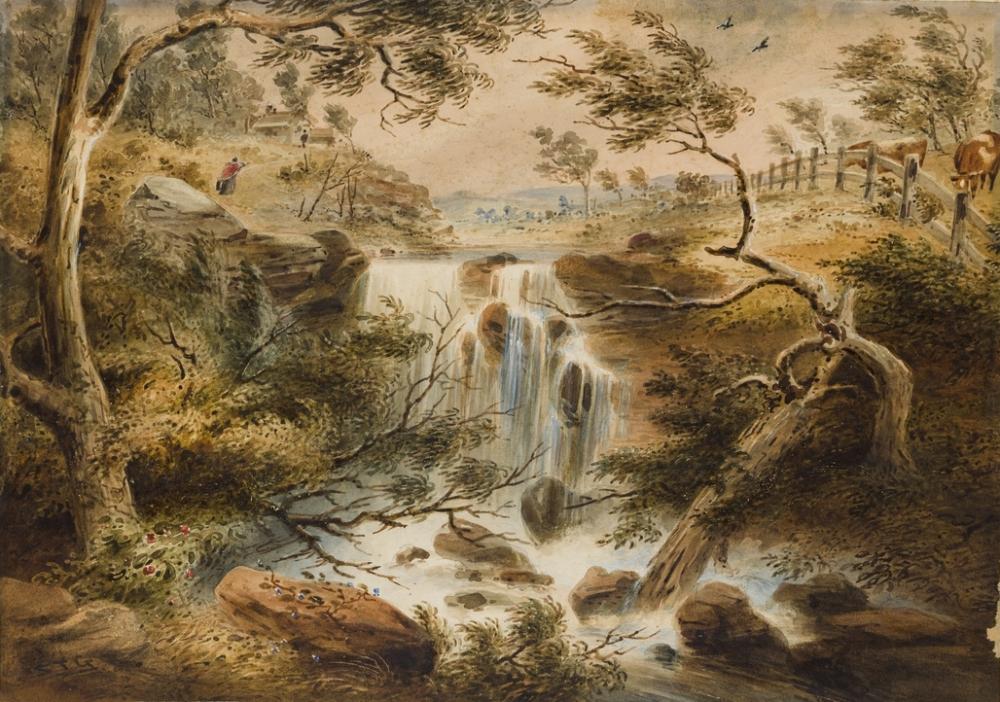
Harnett's Falls, Mosman Bay, 1874 / Samuel Thomas Gill, Image No.: a6243001, courtesy State Library of NSW.
Yachting' Past and Present, Prince Alfred Yacht Club. By FOR'D-HAND. NO. IV.
THE advertisement which the founders of the Prince Alfred Yacht Club inserted in the 'Sydney Morning Herald of October 15, 1867, gives no indication of the importance to which that institution has since attained. It is in modest terms, and runs as follows: — 'Mosquito Yacht Club. Boat-owners wishing to join, please meet at M'Grath's at 8 to-night.' It appears from the first annual report, subsequently issued, that the club was not established 'in any spirit of rivalry to the Royal Sydney Yacht Squadron, but in order to promote the interests of yachting by meeting an existing want, viz., a club which would embrace small yachts, such as were ineligible to join the already established club, or of which the owners preferred joining another club.' The necessity for such a club was a real one, as will be understood when it is remembered that, at this time, the Squadron did not admit to its 'register boats under five tons measurement, under the old Thames rule.
In accordance with the advertisement, the following gentlemen met at M'Grath and Punch's Hotel, King-street: — T. Strickland. L. Windeyer, J, Graham, -- Gray, J. R. Walters, P. Brown, P. J. Clarke, R. C. Boake, W. G. Langley, — Lomaxi, W. E. King, and — Cox. Mr. Strickland took the chair, and the meeting, knowing well what it wanted to achieve, lost no time in coming to a decision that a club should be formed, and in passing Mr. Walters' motion, — 'That the club should be designated the Prince Alfred Yacht Club.' And so, to adopt a metaphor understandable of boating men, the club came smoothly off the slips, and took the water for the first time. As the nucleus of its fleet the following boats were entered on the register: — The Australian, Lurline, Dora, Spray, Scud, Cruiser, and Flying Scud. Among other business transacted was the choosing of club flags, these being an ensign and burgee of white with a red cross. The first general meeting was held at the above-mentioned hotel on October , 1867, and, after a long sitting, was adjourned to the 28th, when the rules of the club were discussed, and finally settled. Among these may be mentioned a rule to the effect that all yachts racing in a club match should be manned entirely by members of the club, and also one of personal interest to the secretary, which authorised that officer to keep a register of all yachts for sale, and to receive a commission of 25 per cent, on the purchase money of boats sold. Neither of these now appears in the club rules. Mr. Strickland was elected commodore till the annual meeting, which was set down for the following January.
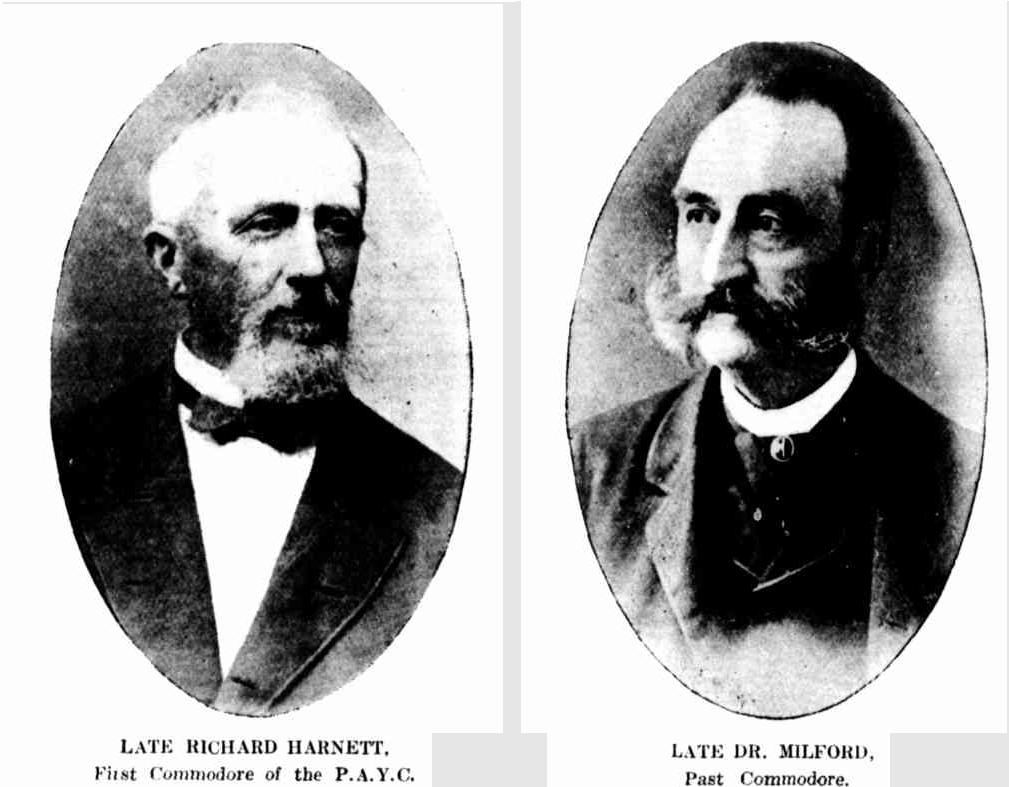
LATE RICHARD HARNETT, First Commodore of the P.A.Y.C. LATE DR. MILFORD, Past Commodore.
The opening cruise took place on December 7 following, and it appears from the 'Herald's' report of the function that the following boats put in an appearance: — Australian, Gitana, Daisy, Ixion, Emma, Lurline, Royal Oak, Irene, Galatea, Dora, and Spray. These, however, did not comprise the whole of the club's fleet, as the number then on the register was 20.
Mr. Strickland was in charge of the gathering, flying his pennant from the Australian, and when he hoisted his signal of 'Make sail' at the rendezvous in Lavender Bay the boats got under weigh in a port and starboard division. By the time the fleet had beaten down to Bradley's Head in the north-easterly breeze the weather had begun to look dirty, and the order 'to part company' although, as it turned out, was not necessary, was, at any rate, a prudent one. The report forms an interesting note on an aspect of the weather in these waters of ours which the boating man of to-day will be able to comprehend: — 'The order to part company was followed by a general lowering of sails and making snug for a 'buster.' Close-reefed mainsails and storm jibs speedily took the place of the fine weather sails which were spread a few minutes before. The north-east breeze died- away, and, almost simultaneously, a light puff from the southward followed; the scud broke over the city as if the next instant would see Port Jackson lashed into a white foam, and then, strange to say, the storm went off in a north-westerly direction. Some shook out their reefs, and sought their moorings, while others, believing the worst had not yet come, kept under snug canvas. It was, at the worst, only a thunderstorm, and after the wind hauled round again to the north-east it blew rather sharply, and sent down a deluge of rain, such as must have benefited the land, even though it made those afloat without waterproofs very uncomfortable, and effectually damped the termination of the day's sport, rendering the intended visit to the vice-commodore a proceeding more honoured in the breach than the performance.'
The report, however, seems to be hardly correct in referring to Mr. Strickland as the vice-commodore. The first annual meeting was held on January 2, 1868, when Mr. Richard Harnett was elected commodore, and Mr. Strickland, who had taken so active a part in the formation of the club, received second flag. The following officers were appointed: — Hon. treasurer, Mr. Langley; hon. secretary, Mr. Gray; comitteemen, Messrs. Brown, M'Taggart, Boake, Merriman, Graham, and King; and auditors, Messrs. Windeyer and Walters. Of these good men and true, who formed the first officers of the club, mention should be made of the commodore. In Mr. Richard Harnett the club had found, to use the words of the 'Herald's' report, 'a yachtsman well qualified for the post,' an enthusiastic boating man, and a clever skipper. He was also a designer of bold and original ideas. He showed that he had the courage of his convictions when he built that remarkable vessel, the Australian, whose extraordinary success against boats of much larger tonnage proved the value of his judgment in the matter of yacht form. (Continued on Page 1311.)
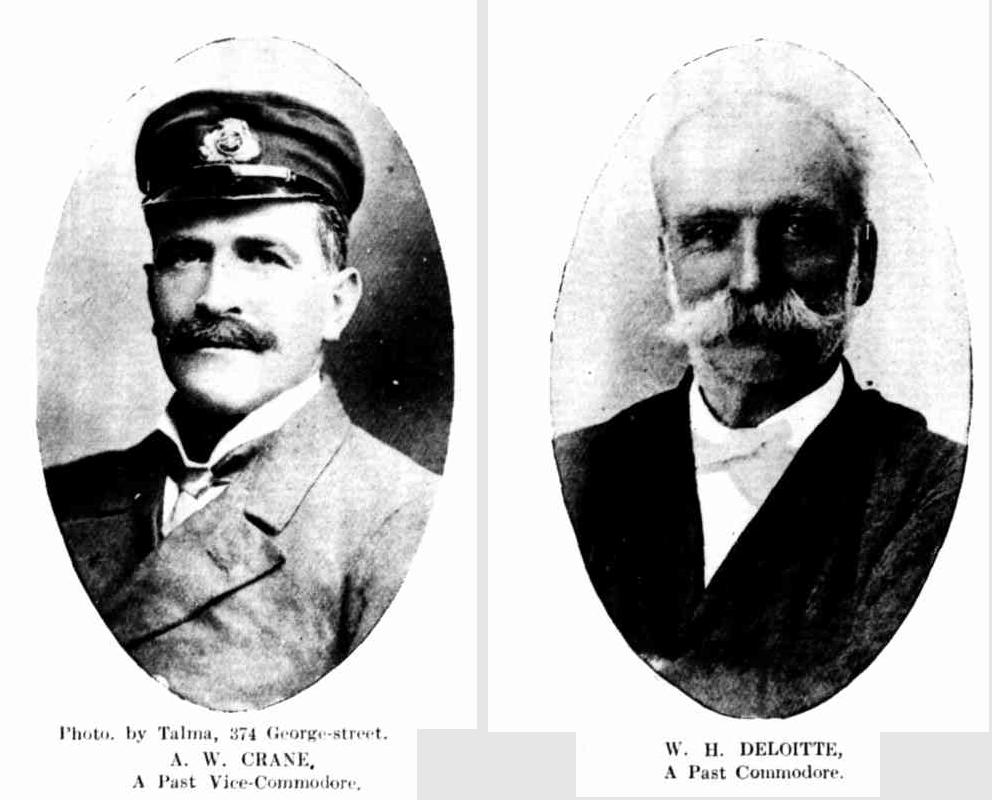
Photo, by Talma, 374 George-street. A. W. CRANE. A Past Vice-Commodore. W. H. DELOITT:, A Past Commodore.
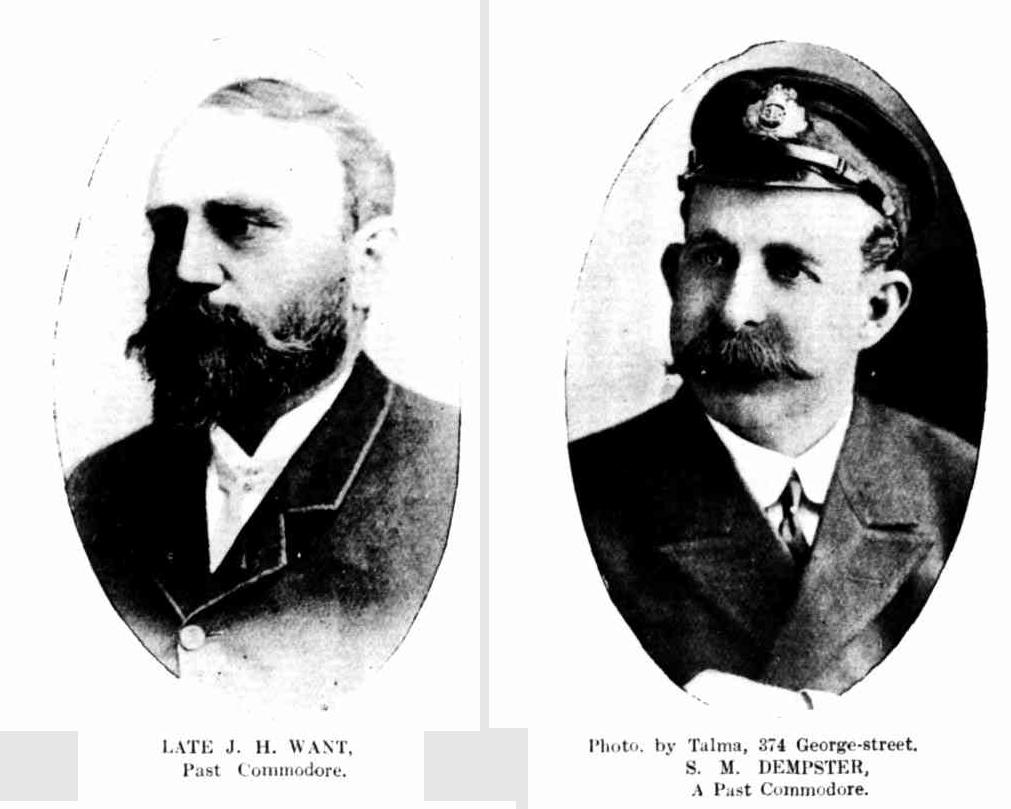
LATE J. H. WANT, Past Commodore. S M Dempster, A Past Commodore
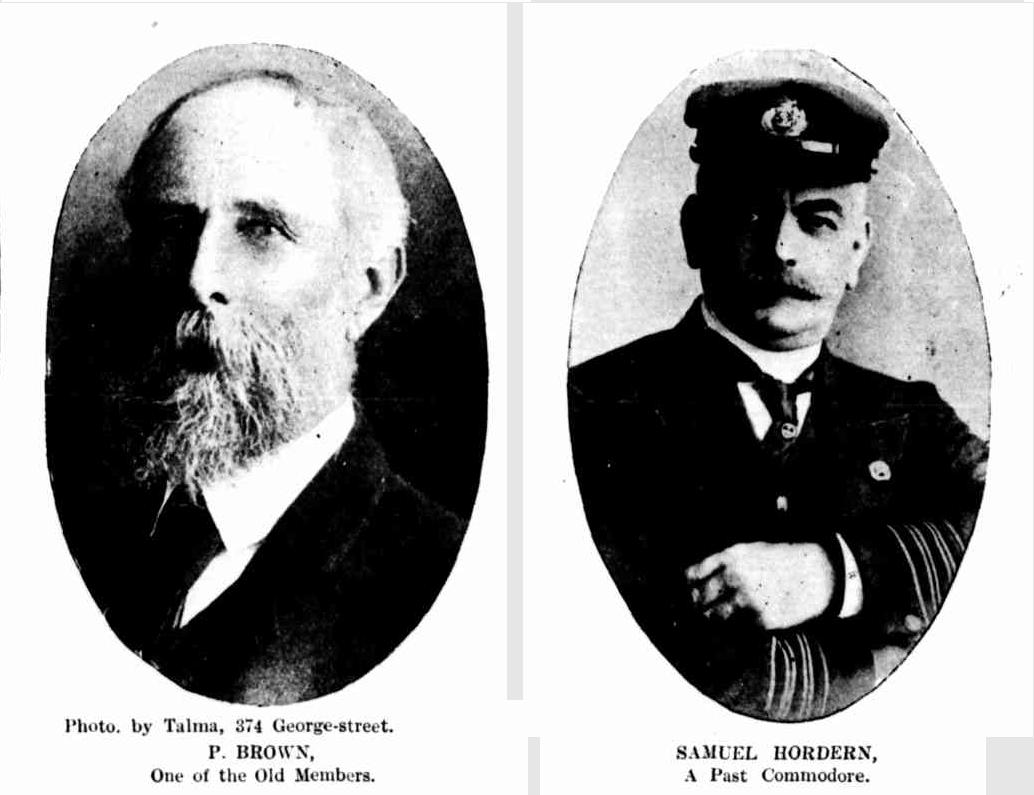
P. BROWN. One of the old Members SAMUEL HORDERN, A Past Commodore.
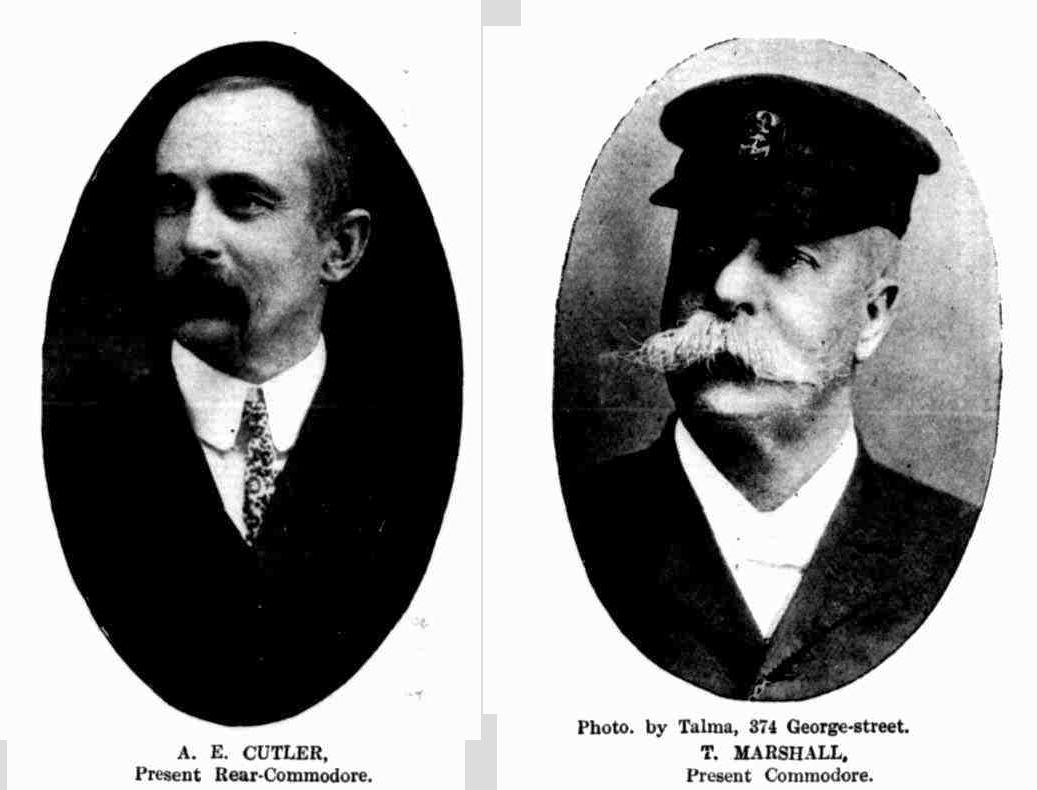
A. E. CUTLER, Present Rear-Commodore. Photo, by Talma, 374 George-street. T. MARSHALL, Present Commodore.
YACHTING PAST AND PRESENT. PRINCE ALFRED YACHT CLUB. BY FOR'D-HAND. (Continued from Page 1334.)
As supplementing the brief notes on. the 'Australian already jotted down, the following extract from a letter written in 1894 to him by the late Mr. George Thornton, another devoted sailorman, may be quoted as showing that the club's first commodore was ahead of his time, not only in Australia, but in England:— 'When I went to England— I think it was in 1864 — you gave me drawings, etc, Of the old Australian. I am not sure whether or not you also gave me a model. I saw Mr. Ratsey and Mr. White, the celebrated yacht builders, at Cowes, and showed the drawings, etc, to them. They seemed to think highly of them. Mr. Ratsey said he would build a five- ton yacht from them. I left them with him. I think he did so, but I never beard with what result. I had also shown them to Hatcher, the great yacht builder of Southampton (of old-fashioned plumb stem Cutter yachts). He, pointing to the raking bow and sternpost of the Australian, ridiculed them.' It will be remembered that in January, 1868, H.R.H. the Duke of Edinburgh visited this colony, and that the arrival of the Galatea in the harbour was made the occasion of many celebrations and much rejoicing. The squadron and the Prince Alfreds joined in welcoming the Royal visitor, and added much to the general effect when their boats formed two lines between which the warship passed on her way up to Farm Cove, and then followed her in line, Mr. Dangar, in the Xarife, leading the squadron's fleet, and Mr. Strickland following In the Australian, in command of ten of the club's boats; all the boats anchored near the Galatea, and took part in the illuminations which were given at night.
The sensational attempt on the Duke's life which was made by O'Farrell in the following March, at the Sailor's Home picnic, at Clontarf, stirred all classes of the community, and we find reference to it in this minute of the club, made during the next ensuing month: — 'That application be made to the Admiralty for permission to fly our present ensign (white with a red cross) and that as a memorial of the visit of H.R.H. the Duke of Edinburgh, and his providential escape from the hands of an assassin, the ensign be known in future as the Prince Alfred ensign.' The application was made, but the Admiralty, in its reply (dated October 21, 1868), did not refer to the white ensign, but slated that there was 'no objection to granting permission for yachts belonging to the Prince Alfred Yacht Club to fly the blue ensign, with a distinguishing mark thereon.' Later on, In a letter dated July 21, 1869, the Admiralty informed the club that 'the blue ensign with a ducal coronet' could be adopted, but asked for information as to the burgee that the members proposed to fly. After some consideration, the club wrote the Lords Commissioners that the burgee decided on was a blue ground, with a broad red cross. And this ensign and burgee are the club's flags of today.
The first race held by the club took place on March 7, 1868, in a light breeze, varying from north-east to east, and a strong flood tide. Nine boats started, being divided into Jhree classes, as follows: — First-class. Irene. Mr. M'Taggart; Challenge, Mr. Andrews; and Australian, Messrs. Graham and Windeyer. Second-class: Galatea, Mr. Gray, and Emma, Mr. Farmer. Third-class: Royal Oak, Mr. Creed; Ixion, Mr. Brown; Dora, Vicec-ommodore Strickland ; and Ino, Mr. Langley.- Australian led all the way, and finally drifted in at 6 o'clock, half an hour ahead of the next boat, and won in her class. : The middle and smallest classes were won by Emma and Ixion respectively. Challenge had bad luck, and managed to get ashore twice. Commodore Harnett was in charge of the race, on board the Scud, and after the race was over entertained the crews of the competing boats. The matter of club uniform came up for discussion in this year, and it was decided 'that the uniform of the club be blue coat (sac, double-breasted) and vest, white trousers, and straw yachting hat with blue ribbon, a costume which commends itself as being neat and workmanlike, except in the matter of headgear, which must have been, an expensive item, unless prevented from getting adrift by some ingenious form of preventer backstay. The progenitor of the comfortable cap of the present day, no doubt; made its appearance at an early date.
The first annual report, which was read at the annual meeting, held in January, 1869, shows that the club was a healthy youngster, Inasmuch as it appears from the document that during the first 12 months of the club's existence 18 boats had been placed on the register, and the membership almost touched the century. It also appears that the sinews of war were there, the cash balance being on the credit side. The concluding words of t-3 report are worth quoting, and may, even in these latter days, be profitably read, marked, {learnt, and inwardly digested by men of this tor any other club who have the interest of the sport at heart: — ''We beg to impress upon each member of the club the necessity of taking an active interest in its progress. The mere fact of paying the annual subscription or attending one meet a year is not the mode toy which the success of the Prince Alfred Yacht Club will be established. It is necessary that both members and officers should feel that much of its future prosperity depends on their individual efforts.' Business affairs prevented Mr. Harnett from continuing as commodore, and, at the meeting, Mr. J. W. G. Hanks was elected in his place. In the following year we find some enterprising spirits entertaining ideas of a waterside club-house, with 'a 'slip for hauling up boats. The matter went as far as the appointment of a committee, but no tangible result of their deliberations appears on the records. In this year three club races were sailed. Commodore Hanks's Cup was won by the Australian, with Mr. Andrew's Eva second, and in the ordinary club events Mr. Strickland's Poiriona beat the Australian in the first-class races, and Mr. Walters's Torment annexed first prize among the second-class boats, with Mr. Bradford's Clio second. The two races were sailed in a hard southerly, which seems to have given the crews plenty of exciting work, and the annual report of the year grew enthusiastic as to the efficiency of the hands who brought their boats through. In 1872 the club laid down a definition as to the minimum size of boats eligible for admission to the club, and established the limit to 22 feet on the load-water line, and 7 feet 4 inches beam. The use of tanned sails seems to have been common, for we find a prohibition laid down against the wearing of club colours on boats carrying sails of this kind. Three classes were formed, and separate races were held for each, viz., first-class, 35 feet and over; second-class, over 25 feet and under 36; and third-class, under 25 feet. The system of double handicap — one for windward work, and the other for a lead — was. in use, and might be profitably resuscitated by th« handicappers of these days, when big and small yachts are racing together.
Apparently, the ordinary method of handicapping by special officers appointed for the purpose was not always considered satisfactory, for we find that it was not uncommon for each owner to send in a handicap of his own, and the commodore struck an average of the various time allowances given to'each boat. Mr. F. J. Jackson was just as enthusiastic a member of this club as he was of the Royals, and seemed to be flying his racing flag, wit'j its blue ground and yellow bar, wherever there was a race to be sailed. We find him winning the commodore's cup in 1872 in the lone, with Osprey, E. Kirchner, second, and also in the following year taking the same event with Scud, II. Woolnough second. On the retirement of Mr. Hanks, in 1872, Mr. W. H. Deloitte, the vice-commodore, received his promotion, Mr. T. M. Brown, the owner of Alick, taking second flag. The last-named boat was a remarkably fast little ship of 9 tons, built for Mr. Brown at the old A.S.N. works, and launched in the September of 1871. Her design was almost that of the Australian, but her keel was more conventional, and ended in a true sternposr, and her sides had no 'tumble home.' Her frames were of ironi and it is not unlikely that she was one of tie first boats in which the combination of metal and wood was used. Her dimensions, appear extraordinary to the boating man of to-day; they were 52 feet over all, 42 feet from stemhead to steropost. 8 feet beam, and 6 feet draft. She was asked to carry a great spread of canvas, as her mast was 40 feet, topmast 24 feet, boom 38 feet, gaff 28 feet, and bowsprit 14 feet. She won her first race at the Balmain regatta of 1873, when she was entered as an eleven-tonner, and easily beat Ella, Scud, Australian, Iris, and Osterley in a strong south-easter, after giving them time allowance.
The report shows that much interest was taken in these matches, and the doings of the competitors before the race, like the preparations of horses for turf events to-day, were matters of great concern: — 'This was looked forward to as- the event of the day, and great disappointment was felt when It was rumoured that Alick had carried away her rigging on the previous afternoon; but Jack Carrol and his crew went to work with a will, and by daylight next morning had a new set of rigging, and she was seen getting away from her moorings at 10.30.' The Anniversary Day race of the following year must have been an exciting contest, and the report makes good reading. Alick apparently sailed a fine race in a howling nor'nor'easterly, and after sailing over an outside course round a boat off Curl Curl and then round the Flagship and Sow and Pigs, she led over the finishing line nearly six minutes ahead of Pert, J. F. Josephson, nearly, nine minutes ahead of the smart little Nereid, A. Fairfax, and over 12 minutes in front of the Ella, A. Farmer. Although Pert was a much larger boat she received a time allowance of 6* minutes, and so the Alick lost the £50 prize'by about half a minute. The result of the race seems to have caused dissatisfaction among the boating men, and Mr. W. E. King, a keen sailing man, in a letter to the 'Herald' a few days after the event, puts it plainly that the Alick had been badly treated by the handicappers. He stated that it was considered desirable by some to discourage boals like the Alick, on the ground that they were not yachts but racing machines, but when we learn from the totter that the boat which was then looked on by some as a freak had sleeping accommodation for eight men, and deck room for a working crew of twelve, carried more sail and stood up to it better than any boat of her class, the thought arises that it would be interesting to see' what those conservatives would think of some of the modern boats, like, for instance, the Sunbeam or the Janet. Mr. King was more enterprising, however, and came to the conclusion that if the Alick was a racing machine the sooner they left off building yachts and took to machine-building the better. The Alick was afterwards lengthened, and her stern altered, but these changes spoilt her, and she was not the same certain winner afterwards.
Commodore Deloitte owned the Ianthena, a large centreboard boat, stated to be twice the dimensions of the 22-feet waterman's skiff of those days. Off the wind or on a lead she was very fast. In the Anniversary Regatta of 1874 she was called on to give Aiick, th' only other competitor., sit minutes, and she appeared likely to do it. as she had more than hall '-r time in hand at the end of the Jti-rt round, but off Bradley's on the second turn down she carried away her boom, leaving Alick to finish alone. . * (To be Continued.}. Yachting Past and Present. (1907, November 20). The Sydney Mail and New South Wales Advertiser (NSW : 1871 - 1912), p. 1311. Retrieved from http://nla.gov.au/nla.news-article163659078
"Pleasant Water Parties" - HARBOR GLORY - First Race In 1818 MOSQUITO CLUB DAYS
(By Walter E. Bethel)
For ages before the white man came, the aborigines skimmed the surface of Port Jackson in their bark canoes. We can hardly call them yachtsmen, however, for they never I seem to have evolved a sail. In a letter written on March 7, 1791, Elizabeth Macarthur describes a boating excursion to Watson's Bay and speaks of the "pleasant little water parties" that she promised herself. From that day to this Port Jackson has been the playground of Sydney till to-day . it serves the purposes of over a million inhabitants, We talk of the mosquito fleet, but 80 years ago there was an aquatic body with the gorgeous name or the Mosquito Yacht Club. And can we match to-day the old world courtesy of the yachtsmen who remarked to his guests as the craft heeled over: "Gentlemen, we are about to capsize," and added a minute later: "Gentlemen, we have capsized."
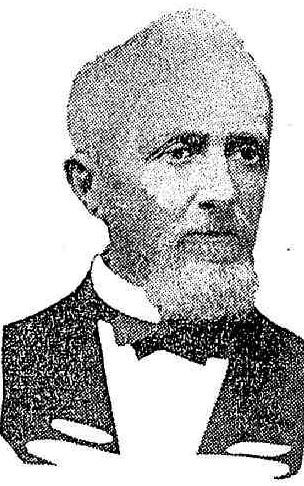 Right: The Prince Alfred's first commodore , Mr, Richard Hayes Harnett, who made yachting history in Sydney when he built his remarkable boat , the Australian.
Right: The Prince Alfred's first commodore , Mr, Richard Hayes Harnett, who made yachting history in Sydney when he built his remarkable boat , the Australian.
Much history has been made on Sydney Harbor since Robert Campbell sailed the first pleasure boat on its waters. She was an open boat about three tons reckoning by yacht measurement — a 3-sticker — with sliding Guhter sails in those days — the approved type being particularly recommended for windward work. The lofty Marconi mast of the present day secures the same advantage — but the Gunter rig, peaked the sail the same way through a topmast, arranged with sliding bands, so that it would readily slide up and down the lower mast. Aquatic sport has naturally flourished in such a setting as Port Jackson. As early as 1818 Captain Piper organised the first boat race, in which his crew defeated those of three ships then in Port, the Guildford. the Minerva and the Batavia. Room for All More recently yacht squadrons, sailing clubs and regatta committees have assiduously carried on the task ol providing for the competitions that occupy so large a place in the history of our national recreation. Yachting and boating naturally mean more to the people round Port Jackson than to less favored spots. From the pulling skiff to the launch, from the canvas dinghy to the stately yacht, there is room for all. It is a \ popular form of breakaway from life's routine, and the cruise and the camp are among the most effective methods of relief from drudgery. Behind sailing as an organised sport, there is necessarily a background of formality, of etiquette Icrgoly adapted from naval practice, which is the basis of the regulation of all yacht squadrons; cast iron procedures are laid down for all craft flying the club's burgee. Thus is noticeable not only in the rules that govern racing, but in the features of ceremonial routine, such as the rendezvous, and other special evolutions. The public, viewing the spectacular work of the squadrons, realises little of the inner workings. The records of all yacht clubs must be interesting, but, if they resemble those of the Royal Prince Alfred Yacht Club, they are something more — they are fascinating, because they have been interwoven with a running commentary of the facts bearing on the inauguration, history and progress of the club from its earliest operations. Yachting Record This has not even been printed, but it exists as many typewritten sheets, bound up with photographs — a rare record of intimate facts, which could only be produced as a labor of love by one who has been closely associated with the club's doings. When, therefore, Mr. L. C. Waterman, president of the Sydney Yacht Racing Association, an old club member, prepared an historical sketch dealing with the club's affairs, its men and yachts, dating from 1867, ho presented his fellow-members with a record that has preserved the sentiment of past years — the personalities of former commodores, and the achievements of yachts whose names are not familiar to the present generation. Mr. Waterman acknowledges the help of such old-time yachtsmen as Mr. F. J. Jackson and Mr, F. S. Adams, with whom and with the secretary, Mr. Buchanan, he has prepared his memento. This article owes much to Mr. Waterman's work. It can give only the outlines of the 68 years of the club's existence. The club has been controlled by 16 commodores: —
Richard Harnett 1868 to 1869
J. W. G. Hanks 1869 to 1872
W. H. Deloitte 1872 to 1877
J. H. Want 1877 to 1882
Dr. Milford 1882 to 1888
W. M. Maclardy .. .. 1888 to 1891
H. S. Harden .. - 1891 to 1892
Samuel Hordern .. .. 1892 to 1905
S. M. Dempster .. .. 1906 to 1907
T. Marshall 1907 to 1908
N. H. Murray 1909 to 1914
W. M. Marks 1914 to 1921
P. Ross .. 1921 to 1922
A. Wilson 1922 to 1923
Sir Dudley de Chair . . 1923 to 1927
Sir Philip Game .. .. 1927 to 1935
Came the Mosquitoes
Before any of the yacht squadrons came the Mosquito Yacht Club. According to a clipping in the Prince Alfred Yacht Club records, the office bearers of this club were: — President, Robert Campbell, M.L.A.; treasurer, Peter Curtis; lion, secretary, W. J. Johnston; auditors, Messrs. J. McDonnell and G. Grime; umpire, G. Driver; committee, Henry Dodds (chairman), J. Bell, W. Nash. J. Pasttley, W. Smith, W. Turner, G. Driver, A clause in the rules limited the length of the club's boats to 13 feet on the keel, measured along the gar-board seam. It was apparent that the Mosquito Club was the first organisation of its kind, and we are told that when the Dunbar crashed at the Gap, in 1857, club members sailed their boats down to the Heads and helped to pick up the bodies of the victims.
The Prince Alfred Yacht Club records show that on Tuesday, October 15, 1867, the following advertisement appeared: — "Mosquito Yacht Club. — Boat owners wishing to join, please meet at McGrath's at 8 o'clock to-night."
The meeting was duly held at Punch and McGrath's Hotel, In King-street.- T. Strickland, a well-known yachtsman, was in the chair. Those present were L. Windeyer, J. Graham, Grey, J. R. Walters, J. Brown, P. J. Clark, B. C. Boake, W. E. Langley, Lomas King and Cox.
New Name
A motion by Messrs. Langley and Graham was carried, that the new club formed that night be designated "The Prince Alfred Yacht Club." Those present, therefore, may be regarded as the founders of the present club. The Royal Prince Alfred Yacht Club thus grew out of the Mosquito Club. A general meeting of the new club was held on October 21, 1867. Colors were adopted and rules drawn up. Mr. T. Strickland, the vice-commodore, acted as commodore pro tern, until Mr. Richard Harnett was appointed in 1868. W. Reading seems to have been the first honorary secretary. The club had its first opening day on December 7, 1867, when the club colors were worn for the first time. Application had been made to the Admiralty for permission to fly the club's ensign, and permission was received to fly the blue ensign with white ducal coronet in the fly. The burgee was then approved as follows: — Blue with red cross, the coronet in the ensign to be red. When the right to prefix "Royal" was conferred on the club in 1911, the burgee was altered by the addition of a crown in the upper canton.
After the first year it became necessary to define a uniform for the club, and this took shape as follows:—
Straw Hats
Blue double-breasted coat and vest, white trousers and (ye gods) straw hats, adorned with blue ribbon. How much these hats were worn in the long ago, is not stated, but apparently not for long, judging by a comment in the records, that if the use of the straw hat was to extend to the forrard hands, it would prove a prolific cause of profanity, (Hid that after a Saturday's blow, there would be a goodly supply of "straws" floating in the Harbor on Sunday.
At the first opening day, the following yachts took part: Australian, Gitana, Daisy, Ixion, Emma, Lurline, Royal Oak, Irene, Galatea, Dora and Spray. Mr. Richard Harnett's appointment as the first Commodore was announced before the close of the year and he took up his duties from 1868. At the end of 1868, good progress was reported. Mr. Harnett could not see his way to continue the Commodoreship beyond 1868. Mr. J. W. G. Hanks was appointed and carried on till 1872. The first year 1868 showed 18 yachts on the list and nearly 100 members. During Mr. Hanks's rule it was decided that all yachts should be rated according to tonnage calculated on tills formula: —
Tonnage Formula
The length from the outside stem head to the outside of stern post, multiplied by the extreme beam, and divided by '94, the quotient to be considered the tonnage. This was the Royal Thames's Yacht Club measurement. In 1870 the purchase of a water frontage for slip and club house was discussed but nothing was done. Commodore Hanks was presented with a silver salver. Vice-Commodore Strickland's yacht, the Pomona, carried off the first prize for first-class yachts, Mr. Graham's Australian being second.
In 1872 the following classification of yachts was agreed upon:— First class: 35 feet and over. Second class: Over 25 feet and under 35.Third Third class: Under 25 feet. A novel handicap system was in force in those days. Each yacht-owner entered for a race sent in a handicap for all yachts, except his own, and the commodore struck an average. Two handicaps were made, one for leading and one for working to windward. The Commodore's Cup for 1872 was won by that fine yachtsman, Mr. F. J. Jackson, in the Ione, with Osprey second and Scud third. Mr. Jackson gained most fame through his fast 10-tonner, the Violet, which showed a clear pair of heels to most in Its class. He was commodore from 1878 to 1882.
Waterside Quarters
Mr. Hanks resigned at the end of 1872, and was followed by Mr. W. H. Deloitte, who remained in the position till 1877. Then came Mr. J. W. Want's period (Jack Want, as he was to everybody). He held the post till 1882. The club nearly secured waterside quarters In 1878. Mr. Want pushed the question. Mr. Harnett offered land in Middle Harbor on a point near the Quaker's Hat, just round the corner from Pearl Bay, but funds were not available, and the matter was dropped again. In 1880 Mr. J. Henniker Heaton, of penny postage fame, then connected with the "Town and Country Journal," gave, on behalf of the "Town and Country Journal," a cup for club competition. Mr. Henniker Heaton afterwards left for England and became a leading politician, being finally created a baronet. The cup was won by Mr. Want's Guineviere. Dr. Milford succeeded Mr. Want in 1882, and held office most successfully till 1888. Dr. Milford was an enthusiastic and practical yachtsman, who had several fine boats built, and personally handled them all. These were the Doris (5-ton), the Sao (6-ton), and the Isea. Dr. Milford took the Doris to Melbourne in 1883 and carried off the first prize in the third section. When congratulated by the club on his success, he remarked that he had grown tired of sailing round the buoy at Manly and back to the red one at Fort Macquarie. On the Way down to Melbourne the Doris broke the main boom off Twofold Bay. She put in to that port, and the crew improvised a boom from a sapling, and sailed on.
Curious Finishes
Curious finishes attended some of the races. On November 24, 1883, the first race of the season was won by Waitangi (Milson), 1st with Sirocco (Knox) 2nd, and Australian, H. Stevens 3rd. The second contest followed on February 9, 1884, and the same three yachts filled the same places. A protest was raised against the Waitangi, and she was disqualified for an Infringement of rule 4 of the sailing directions, as having been commanded by a non-member of the club during the race. The prize went to Mr. Knox of the Sirocco, but he declined to take advantage of the position created by the Waitangi's disqualification, and the race was re-sailed. This time the Australian (the Lemonade Bottle, as she was called) came in a winner.
Under Dr. Milford's Commodore-ship, outside races to Broken Bay, and to a mark off Wollongong, became more frequent. On December 4, 1886, the following competed in the race to Broken Bay and back: — The Sirocco, 10 tons, E, W. Knox, scratch; Guineviere, 10 tons, J. H. Want, 7min.; Sao, 6 tons, Dr. Milford, 20min.; Assegai, 6 tons, G. F. Mur-min, 20min.; Carina, 9 tons, Captain Gascoigne, 25min, Captain Gascoigne was A.D.C. to the Governor, Lord Carrington, and the Gascoigne Cup, now periodically raced for, has kept his memory green. Dr. Milford won with the Sao, Mr. Want's Guineviere being second.
The Wollongong race was won by the Assegai (G. F. Murnin); only four started. The winner was the only boat timed to finish.
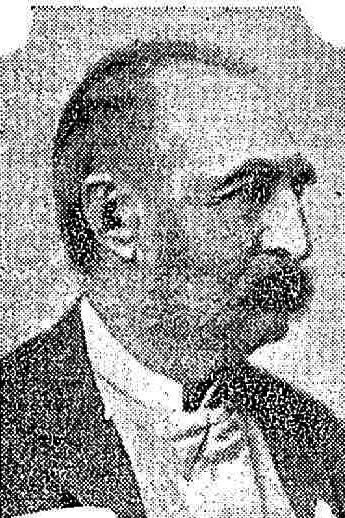 The doctor resigned from the commodore-ship in 1888. No commodore has a better record for personal and practical work. He handled four yachts in his time. The Doris, the Sao and the Isea were built to his order. He also ran the Waitangi for a season.
The doctor resigned from the commodore-ship in 1888. No commodore has a better record for personal and practical work. He handled four yachts in his time. The Doris, the Sao and the Isea were built to his order. He also ran the Waitangi for a season.
Many stories are told of the doctor, whose courtesy was invariable. He never dropped it under stress. While at the tiller of his son's 16-foot racing dinghy, the Young Jack, and getting into trouble, he said hurriedly, "Gentlemen, we are about to capsize," adding apologetically as the Young Jack turned on her side and filled up, "Gentlemen, we have capsized."
The Sayonara seems to be the oldest yacht of the Royal Prince Alfred Yacht Club in commission. She is owned by Mr. Paul Ross, Commodore of the Royal Sydney Yacht Squadron. Fife designed, she was built in Adelaide in 1897 by Mr. A. McFarlane.
Scanning the lists of the Royal Prince Alfred Yacht Club for the oldest member, I find that my old friend, "Skip" Kellerman, holds that honor. He joined with the Elf, 25 tons, in 1890. The Elf was stolen from Vaucluse Bay some years ago, taken outside the Heads, and wrecked on the rocks off Dee Why. He also owned the Tasma at the same time — and still has her in commission. We sailed a canvas dinghy 57 years ago, but that does not count. Another article is required to cover even briefly the full period of the Royal Prince Alfred Yacht Club's operations. The work of the rest of the commodores, including the late Samuel Hordern, who held office for several years, call for review. The story of the R.P.A. Yacht Club will be concluded in "The Sun" of Saturday, February 23.
Right: Dr, Frederick Milford, a well-remembered yachting enthusiast of the '80', and '90 's, formerly one of Sydney's leading medical practitioners, of whom a highly diverting story is related by Mr. Bethel to-day. "Pleasant Water Parties" (1935, February 16). The Sun (Sydney, NSW : 1910 - 1954), p. 7 (LAST RACE). Retrieved from http://nla.gov.au/nla.news-article230269631
YACHTING FLEET OF 100 Governor Opens The Season For R.P.A.Y.C.
Hermit Bay was no place for solitude yesterday afternoon, when over 100 yachts and sailing boats anchored and dressed ship in bright sunshine.
The occasion was the opening of the 1935-36 yachting season by the Governor, Sir Alexander Hore-Ruthven, Commodore of the Royal Prince Alfred Yacht Club. Yachts of the Royal Prince Alfred and kindred clubs assembled In Farm Cove at 2.10 p.m., and on the hoisting of the signal J.T (follow me in line) on Vice-Commodore Dr. Hamilton Kirkland’s yacht, Riawena, the fleet sailed to the rendezvous In Hermit Bay. Among the assembled yachts were Riawena (Vice-Commodore Dr. Hamilton Kirkland). Boomerang (F. Albert), Norn (A. F. Albert), Vanessa (E. H. Pratten). SJO-RO (Claude Plowman), Culwulla IV. (R. F. Graham), Wanderer (Norman Wallis), Windward, staysail schooner (J. M. Hardie), Oomoobah (P. S. Arnott), Currawong (Philip Pring). Cuthonna (Dr. T. Furber), Thetis (Dr. R. I. Furber), Rana (R. H. C. Down) Koonya (H. Maxwell). Wyunn (C. W. Robson), Down (Oscar Backhouse). Akarana (R. Leigh). Norena (R, E. Millard), Sir Alexander Hore-Ruthven, attended by Captain J. Holford, A.D.C., proceeded to the rendezvous by a speed launch, and boarded the official flagship, Lady Hopetoun, where he officially opened the 1935-36 yacht-racing season. A light nor'-easterly breeze provided ideal conditions for the craft competing in the programme of four sailing events, all of which started and finished within the vicinity of the club steamer. Btirra-Bra. Mischief, with owner Stanley Spain at the tiller, won the race for A and B class yachts of the Sydney Amateur Sailing Club, by 28sec„ from Goora (W. J. Pritchett), followed two seconds later by Maluka (W. Clark). Vale (K. Plowman) and Scotia (D. Holland) finished a dead-heat for first place in the handicap race for boats of the Vaucluse Junior Amateur Sailing Club. Malabar, with owner. J. McDongall at the helm, sailed to victory from 14 other competitors in the race for 10ft. skiffs. Harmony (K. Kershaw) finished second, 2min. 34sec. behind Malabar, The race for 12ft. cadet dinghies was won by Pixie IT., sailed by J. R. Horn, by 29sec. Scamp (J. S. Olsen) and Waterwitch (P. G. Munce), dead-heated for second place. YACHTING FLEET OF 100 (1935, October 6). The Sun (Sydney, NSW : 1910 - 1954), p. 25. Retrieved from http://nla.gov.au/nla.news-article231183270
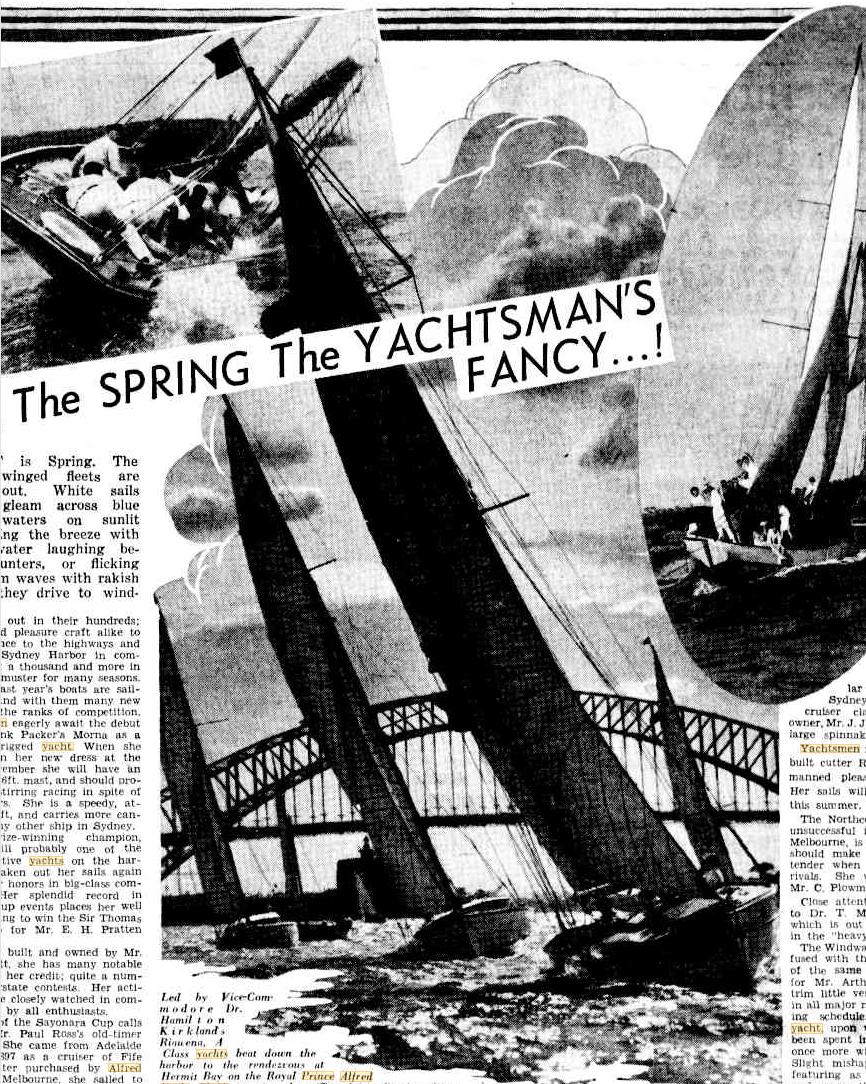
Led by Vice-Commodore Dr. Kirkland's Riawena, A Class yachts beat down the harbor to the rendezvous at Hermit Bay on the Royal Prince Alfred Yacht Club's opening day. (Top left): Beating down towards Bradley's Head in a fine sailing breeze. In The SPRING The YACHTSMAN'S FANCY...! (1935, November 10). The Sun (Sydney, NSW : 1910 - 1954), p. 19. Retrieved from http://nla.gov.au/nla.news-article230174489
ONE OF PITTWATER'S MANY PEACEFUL BAYS.
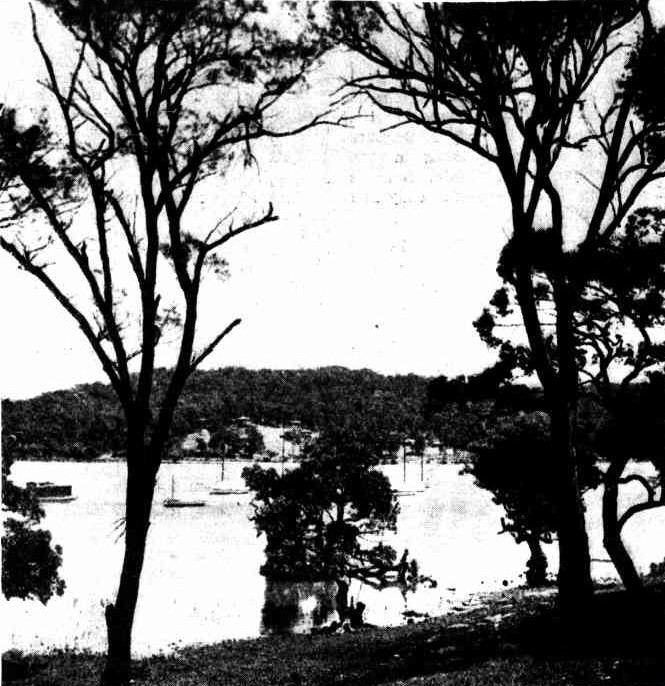
Other pictures of this delightful resort appear on pages 12 and 13. ONE OF PITTWATER'S MANY PEACEFUL BAYS. (1938, December 28). Sydney Mail (NSW : 1912 - 1938), p. 45. Retrieved from http://nla.gov.au/nla.news-article166525372
Rest of The Prince's Visit article:
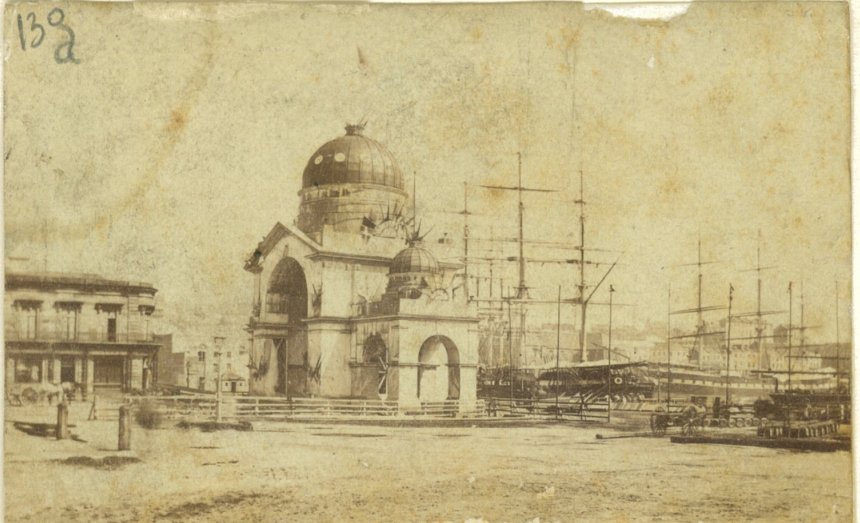
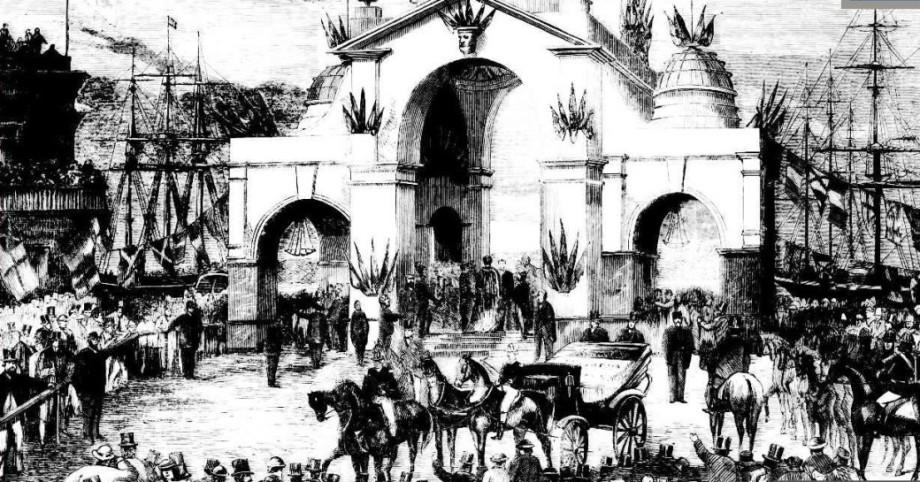
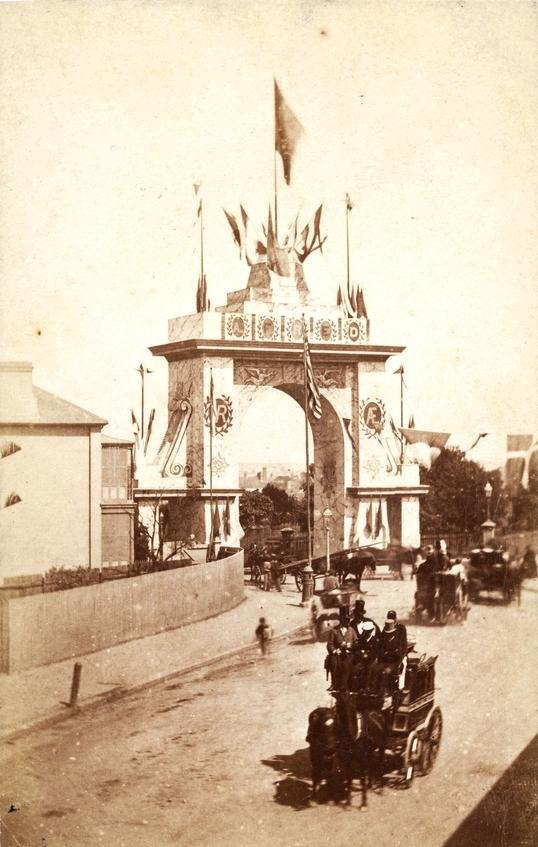 At the Colonial Secretary's Office, a transparency containing several well-executed figures, shewing that Art, Science, Charity, Justice, and Mercy, had their proper place in the Government of this colony. The figures were also intended to indicate the nature of the departments under the control of the Colonial Secretary. "
At the Colonial Secretary's Office, a transparency containing several well-executed figures, shewing that Art, Science, Charity, Justice, and Mercy, had their proper place in the Government of this colony. The figures were also intended to indicate the nature of the departments under the control of the Colonial Secretary. "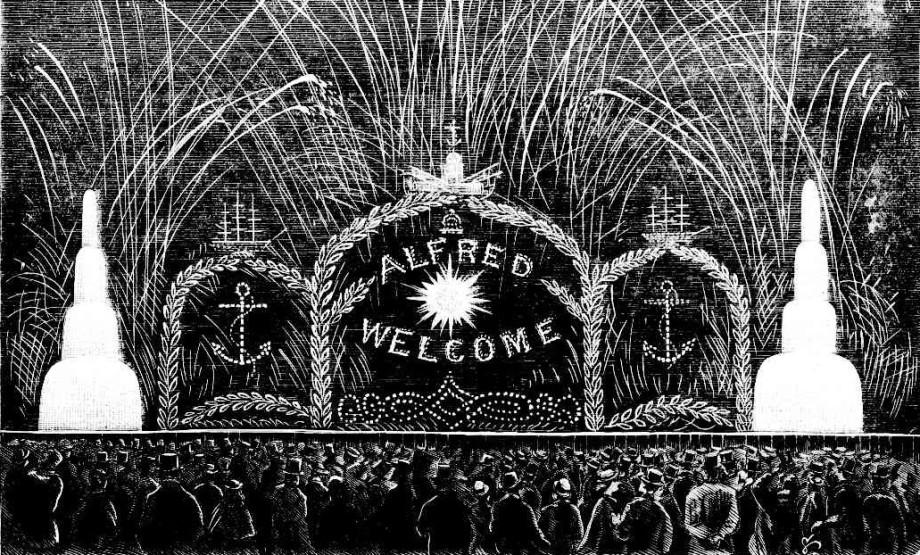
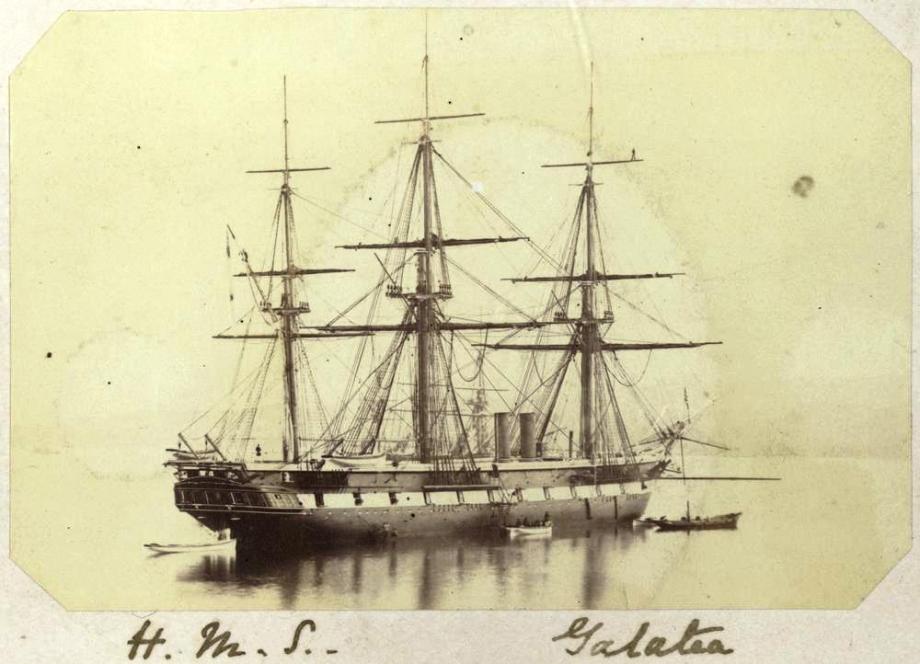
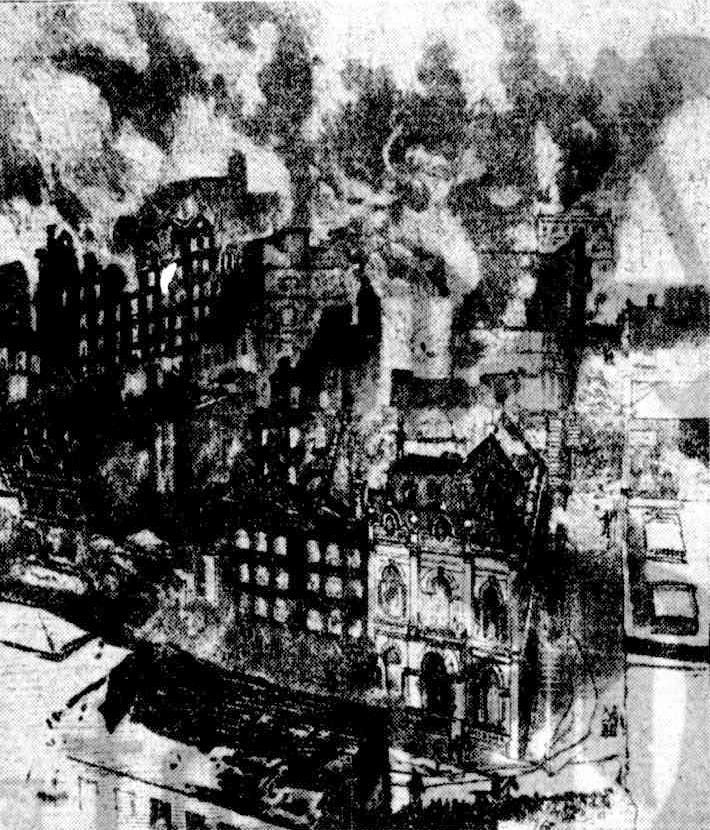 THE GREAT FIRE. MOORE-STREET DISASTER.
THE GREAT FIRE. MOORE-STREET DISASTER.